#I find the concept of AI art fascinating and useful as someone with not a lot of time to use my limited art skills
Text
i want to be a machine learning engineer but some of u guys r making it embarrassing actually. long but IMO important explanation below. We have bigger issues to deal w and better things to focus on.
like our planet is dying and the commercialisation of massive AI models and training the models themselves releases like hundreds of thousands of tonnes of carbon emissions. and this includes very "nonessential" models that don't tend to contribute much to society (re: new fancy image generation toy). but u have decided your new career path is "AI artist" (glorified prompt-writer?) .
and just as bad, some of you have decided the biggest issue w AI is those people, the glorified prompt writers!! you draw more attention to it instead of focusing on the real problems behind AI and the ethics of training models! about the harm it causes to the planet, about web-scraping limitations basically not existing (stolen art falls under this domain), copyright laws to do with AI, the way facial recognition deals with race, about the boundaries between letting AI learn and develop in an "unbiased" way vs preventing sociopolitical damage at the cost of (potentially) further progress.
conversely, there is nowhere NEAR enough focus about how AI can help us overcome some of our fundamental problems. i love machine learning bc i find it - specifically the maths behind it - fascinating and i believe one day it could help us make very cool advancements, as it already has. i think the mathematical architectures and processes behind creating new deep learning models are beautiful. i also know the damage capitalists will inevitably do - they always wield powerful, beautiful new tools as weapons.
AND HERE YOU ARE FALLING FOR IT! it's very frustrating to watch!! if you're angry on behalf of artists, i'm begging you to protect the rights of artists and be mad at greedy companies instead of villanising a tool that can help us immensely! learn about AI ethics, learn about how it is present in our lives, what we should try to stop, what we should promote.
if you "boycott AI" as a whole with no desire to gain more literacy on the topic other than "steals art therefore bad", you will have to be against your translate app, your search engine, your email spam filter, almost everything on your phone that categorises anything (i.e. pretty much all of your search functions), NPC enemies in games, your medical diagnostic tools, your phone's face unlock, your maps app, online banking, accessibility tools that help blind and deaf people, new advancements in genetic sequencing and protein folding and treating cancer and modelling new solutions in physics and so on and so on.
the issue isn't all AI as a whole. the issue is A) how companies are using it and B) how a lot of you guys are getting mad at the concept of AI instead of responding to A.
#lol anyway#u guys r like protect artists rights and then proceed to do 0 research on how#without doing damage to humanity as a whole#and actually tbh a lot of artists contribute to this as well. like i was following a few ppl who had their art ripped off (this must be#horrible and harrowing and i can't imagine how bad the experience must be) and they responded by being like#AI IS EVIL!!! NEVER SUPPORT AI!! which is literally ! meaningless!!!#think about it kind of like nuclear physics. it can help us immensely#it can teach us a lot about the universe and it can help us w finding wonderful new sources of energy. it can be beautiful and fascinating#and it can also be utilised in a very dangerous way. once it is used in a dangerous way (as it has been) you probably wont start blaming#The Concept Of Nuclear Physics. like im gonna guess you guys don't boycott gamma rays or nuclear fission bc someone made an atomic bomb yk#maybe this analogy got out of hand 💀 but you get what i mean#AI#ai art#idk how to tag this lol#anyway#listen to artists but also listen to actual AI experts i am BEGGING U
18 notes
·
View notes
Text
God I see so many posts complaining about AI art and like. You have valid reason to be mad about how it’s being used because it hurts the livelihoods of artists but. Maybe don’t call the people who make/use it “talentless scumbags” if you want to actually change people’s minds about it?
I’ve said this before and I’ll say it again: trying to define exactly what art is is useless. AI art is a problem because it puts artists in danger of poverty, because it can hurt their livelihoods under capitalism, not its existence itself.
It has its pros and cons compared to asking or paying a real person for art or making art yourself. In a vacuum it’d just be another cool technology that people could use if needed. But we live in a society where many artists will starve or at least be in danger of it if AI art takes away their income, so it needs to be discouraged and heavily regulated right now.
#my thoughts#sorry but accusing others of not being born with Talent is not making me any more sympathetic to you#despite us being on the same side because I also want to protect artists from the consequences of it#my philosophical opinion on AI art is this: people accuse it of being soulless; but every part of it is heart and soul#everything in the code had to be made by someone passionate about the end goal and every training piece is art that someone put effort into#what it produces is nothing more or less than the filtered collective idea of whatever prompt it is given#when you ask it for a skyline it will give you what people think is important about a skyline#when you ask it for an apple it will give you what people thing is important about an apple#it is a way of asking for the bigger picture of a single thing; because everything that went into it was a choice someone made#I asked the AI for a library once and the final picture had these hanging lamp-things in it#which means that enough people considered hanging lamps part of a library that the AI put them in as well#and I think that’s beautiful; in a way#I find the concept of AI art fascinating and useful as someone with not a lot of time to use my limited art skills#but the consequences of it in the current circumstances cannot be ignored so it needs to be pushed back against for now
6 notes
·
View notes
Note
are you scared of the whole AI art thing? What do you think about it?
"Scared" is the wrong word, I think. "Pissed" is probably more accurate. The technology underlying the concept is interesting, but its current form transparently functions by mining data from artists who didn't consent to have their work used like that. Arguments over whether it's "real art" or whatever aside, that is unethical and gross and a class-action lawsuit waiting to happen.
I think the people scared that this is going to replace actual living artists are severely overestimating the technology at play here and possibly don't understand computers very much.
The reason why computers are a fascinating mix of very smart and very stupid is because they are only good at doing exactly what they are told. Human thought, communication and creation is based on a process of flexible interpretation. Our brains take in patterns of light and sound and interpret them into shapes and figures and speech - a process that is imperfect, messy and susceptible to any number of disruptions from minor chemical alterations to major brain injuries. We read text and subtext and emotional undertones into what we hear, we extrapolate assumptions from the things we see. It's an extremely messy process with a lot of room for error, as evinced by miscommunications, corner-of-the-eye shadow people, "are you mad at me I feel like you're mad at me", getting hangry, assigning personalities to car taillights, audio processing disorders, and about a million other human idiosyncrasies.
Art, down to its bones, is about interpretation - the artist interpreting a slice of the world and the audience interpreting that art. This is why no two people experience the same story the same way, and why no two artists create the same work.
Computers, in contrast, are not messy. Or, to be more accurate, they aren't naturally messy. They do exactly what they are told. They have no context, no axioms, no common sense and no rules except what they're given. A human told to write a sentence over and over again and never being told to stop will eventually get bored or tired or hungry or pissed and stop. A computer told to 'while 1: printf("Hello World!")' will do it forever until the power goes out or someone notices and forces it to stop. A person told "hey man can you go to the store and get me a mango, and if they have apples get five" will acquire a mango and possibly five apples. A computer told the same instruction may well turn up with five mangos. A computer won't do anything if you forget to close a parenthesis or put in a semicolon somewhere in a thousand lines of code because it's doing exactly what it's told. The eternal frustration of computer science is figuring out why the stupid computer isn't doing what you told it to do, and the answer is always "you didn't tell it what to do right. Find the missing parenthesis. Don't capitalize that one variable."
An artist told to paint a fantastical landscape might paint beautiful mountains or flying cities or the high, arching curves of Saturn-style rings or ancient ruins or massive skeletons or any number of things. A computer told to render a fantastical landscape will, as I understand it, comb through a database it's been given by a human, find works a human or a human-trained algorithm tagged with "fantastical" "landscape" (or, if it's been made a little more complex, a word-web of other tags commonly added by a human to things tagged with "fantastical" and "landscape") and use a very impressive program created by a human to recombine them into a mashup of "fantastical" "landscapes" that may or may not parse correctly to the human who looks at it. The computer doesn't know. The computer isn't thinking. It's just doing what it's been told to do.
If we stop thinking of computers like people that are going to take our jobs and start thinking of them like tools that people use, the whole situation becomes a lot clearer. The technology isn't the problem. The people who baked in stolen datasets and the people who are using the tool to be dicks to artists are the problem. I'm not scared of the tech and I'm not scared of the people - I just wish they'd stop being dicks.
And even if we do reach the theoretical point where a computer can create art that actually stands up to scrutiny - you know, where the hands don't look like calamari plates and the eyes and teeth don't blur together and sharp delineating lines between clothing and skin don't just sort of dissolve into shadowy vagueness - I think that'll be the point we just shift into the "holy shit! two cakes!!" zone. 3D animation didn't make 2D animation obsolete. 4K screens didn't kill pixel art. The printing press didn't kill painting. Video only killed the radio star until podcasts brought them back. People enjoy lots of things.
2K notes
·
View notes
Text
Fics about SecUnit 3 to Read Before We Get All Our Headcanons Jossed
Three! SecUnit 3! System Collapse comes out in one week and it seems like Three will feature prominently!
Three has been the subject of so much speculation and fascination for the fandom. We have a lot of different ideas about who it may become and who it might want to be.
Before all of that gets debunked by the new book, here's a rec list and roundup of some of the excellent fics that center Three!
-
Ficlets About Three and Murderbot Figuring Out How To Interact With Each Other
"Feedlog" by OnlyAll0Saw. 599 words. NR, Multi.
ART is a bit of a bully on the feed. MB is having none of it.
A well-done codefic that imagines the rocky early days of Murderbot, Three, and ART all figuring out how to get along with each other.
-
"Murder Mode Modules" by FlipSpring. 948 words. G, Gen.
3 what the fuck is ‘Murder Mode Modules, Do Not Touch Except For Situations That Necessitate Lots Of Murder?'
Hilarious, great voice, and surprisingly emotional for such a short space and silly tone :') Two excellent podfics!
-
"Real Things" by ArtemisTheHuntress. 715 words. G, Gen.
Three admits that it doesn't understand the appeal of fictional media.
This one's mine :) Murderbot and Three discuss media. There's a podfic!
-
Meatier One-Shots about Three Contemplating Its Identity, Who It Is, And What It Wants Now
"pink and green" by CompletelyDifferent. 5,100 words. G, Gen.
During a diplomatic trip to the university's home system to better establish the newly-formed treaty with the Preservation Alliance, Three tries to figure out who it is. Between exploring new hobbies and its sense of fashion, it attempts to figure out what its relationship with Murderbot 1.0 is, precisely. (Murderbot 1.0 ignores this, until it doesn't).
Hot Springs Episode! CompletelyDifferent @elexuscal writes character interactions SO well.
-
"Uncatalogued and Uncategorized" by lick. 3,033 words. G, Gen.
SecUnit 3 discovers that a hot shower is a good place to work out tangled thoughts.
I loooove this one and return to it regularly. The introspectio makes it a fantastic balance of character study, past trauma, and total confusion of what to do now with itself and its life. Includes a podfic by the author!
-
"Unacceptable Topics of Conversation" by lick. 4,500 words. Teen & Up, Gen.
Murderbot gives SecUnit 3 a haircut. They discuss the governor module.
lick does it again! The feelings are so fraught, the conversation held so gingerly.
-
Long, Plot-Heavy Stories About Three Finding Itself In The Universe
"Heuristic Analysis" by thefourthvine. 11,000 words. G, Gen.
Three makes some choices.
Three travels to Mihira with ART and its crew, gets involved in an AI Rights related mystery, and, as advertised, makes some choices. Well-written with some interesting worldbuilding concepts about the Pansystem University of Mihira and New Tideland!
-
"Seeking Safety" by petwheel. 57,000 words. Teen & Up, Gen.
Three assumes a new identity on Preservation, only to discover someone wants to kill it. To figure out who and why, Three has to delve into secrets from Preservation's past.
A plotty mystery, suspenseful and extremely creative, with some bold and unique takes on Preservation's history - and how Three can fit in.
-
"Function" by FigOwl. 65,000 words. Teen & Up, Gen.
"I have worked assignments solo before, and I have gotten used to the absences of SecUnit 01 and SecUnit 02. But I have not reconciled myself to the absence of Murderbot 2.0, though I know it is not logical. 2.0 made its choices, and fulfilled its purpose perfectly, and it seemed satisfied with that. I wish that I had any amount of such certainty and resolve."
The continuing adventures of SecUnit03. How does a newly freed SecUnit make sense of everything without having consumed 35,000 hours of media for context?
Three goes off on its own self-actualization adventure after Network Effect.
-
Three On Preservation
"words left behind" by torpidgilliver. 4,400 words. G, Gen.
"How do you stand it?"
Dr. Gurathin's tone is slow and even when he asks, "Stand what?"
-
SecUnit 3 shares its feelings with someone who might understand.
Three meets Gurathin. Also, a cat. Delightfully soft and gently sad.
-
"Social Competition" by scheidswrites. 2,100 words. G. Gen.
It's been a while since the last attempted murder/kidnapping, and life is good. Everyone is gathered for a celebration on the Mensah Family Farm.
The rogue SecUnits invent a new sport. Drs Mensah, Gurathin, and Overse talk about work on their day off.
SecUnit sports! Murderbot and Three bonding without being too awkward about it! I love this.
-
"The Tree That Owns Itself" by BoldlyNo. 865 words. G, Gen.
There is a tree in the FirstLanding University Botanical Gardens that Murderbot is not thrilled about.
Murderbot and Three have conflicting feelings about a tree.
-
Miscellaneous But Also Worth Highlighting
"As Your Legal Counsel" by i_have_loved_the_stars_too_fondly. 1,000 words. G, Gen.
Pin-Lee informs Three of its options and legal status, should it choose to come to Preservation.
This one is so fun and sweet! Directly after Network Effect, Pin-Lee talks to Three about its options. Three is a little overwhelmed. Two podfics of this one, one by me :) Also @ilovedthestars your AO3 name is hard to type
-
"Past the Breakers" by Thylacine_Wishes. 5,300 words. G, Gen.
When Three is badly injured protecting ART's crew on a mission, Murderbot finds itself disagreeing with the safety protocols that it had written. It was supposed to be the SecUnit meat shield, not Three. It doesn't have time to figure out how it feels about that before it's diving in (literally) to rescue Three and maybe coming to terms with some things along the way.
Action! Adventure! Edge-of-your-seat drama written SO well! Almost drowning! Murderbot caring about Three!!!!
-
"Team of Three" by Lillow. 5,500 words. G, no category.
How Three of three became Three of many.
The tags say it best: the real team was the friends we made along the way. Or is it the real friends are the teammates we make?
Either way, Three finds a team, and people it belongs with.
#The Murderbot Diaries#Murderbot#SecUnit 3#fanfiction#fanfic recs#fanfic rec list#ALL THREE ALL THE TIME#long post
120 notes
·
View notes
Note
do you support ai art?
that's a tough one to answer. sorry in advance for the wall of text.
when i first started seeing ai-generated images, they were very abstract things. we all remember the gandalf and saruman prancing on the beach pictures. they were almost like impressionism, and they had a very ethereal and innocent look about them. a lot of us loved those pictures and saw something that a lot of human minds couldn't create, something new and worth something. i love looking at art that looks like nothing i've seen before, it always makes me feel wonder in a new type of way. ai-generated art was a good thing.
then the ai-generated pictures got much more precise, and suddenly we realized they were being fed hundreds of artists' pieces without permission, recreating something similar and calling it their own. people became horrified, and i was too! we heard about people losing their job as background artists on animated productions to use ai-generated images instead. we saw testimonies of heartbroken artists who had their lovingly created art stolen and taken advantage of. we saw people being accused of making ai-generated art when theirs was completely genuine. ai-generated art became a bad thing.
i've worked in the animation industry. right now, i work at an animation school, specifically for 2D animation. i care a lot about the future of my friends in the industry (and mine, if i go back to it), and about all the students i help throughout the years. i want them to find jobs, and that was already hard for a lot of them before the ai-generated images poked their heads into our world.
i'm not very good at explaining nuanced point of view (this is also my second language) but i'll do my best. i think that ai-generated art is a lot of things at once. it's dangerous to artists' livelihoods, but it can be a useful tool. it's a fascinating technological breakthrough, but it's being used unethically by some people. i think the tools themselves are kind of a neutral thing, it really depends on what we do with it.
every time i see ai-generated art i eye it suspiciously, and i wonder "was this made ethically?" and "is this hurting someone?". but a lot of it also makes me think "wow, cool concept, that inspires me to create". that last thought has to count for something, right? i'm an artist myself, and i spend a lot more time looking at art than making art - it's what fuels me. i like to imagine a future where we can incorporate ai-generation tools into production pipelines in a useful way while keeping human employees involved. i see it as a powerful brainstorming tool. it can be a starting point, something that a human artist can take and bring to the next level. it can be something to put on the moodboard. something to lower the workload, which is a good thing, imo. i've worked in video games, i've made short films, and let me tell you, ai-generated art could've been useful to cut down a bit of pre-production time to focus on some other steps i wanted to put more time into. there just needs to be a structure to how it's used.
like i said before, i work in a school. the language teachers are all very worried about ChatGPT and company enabling cheating; people are constantly talking about it at my workplace. i won't get into text ais (one thing at a time today) but the situation is similar in many ways. we had a conference a few months ago about it, given by a special committee that's been monitoring ai technology for years now and looking for solutions on how to deal with it. they strongly suggest to work alongside AIs, not outlaw it - we need to adapt to it, and control how it's used. teach people how to use it responsibly, create resources and guidelines, stay up to date with this constantly evolving technology and advocate for regulation. and that lines up pretty well with my view of it at the moment.
here's my current point of view: ai-generated art by itself is not unethical, but it can easily be. i think images generated by ai, if shared publicly, NEED a disclaimer to point out that they were ai-generated. they should ONLY be fed images that are either public domain, or have obtained permission from their original author. there should also be a list of images that fed the ai that's available somewhere. cite your sources! we were able to establish that for literature, so we can do it for ai, i think.
oh and for the record, i think it's completely stupid to replace any creative position with an ai. that's just greedy bullshit. ai-generated content is great and all, but it'll never have soul! it can't replace a person with lived experiences, opinions and feelings. that's the entire fucking point of art!!
the situation is constantly evolving. i'm at the point where i'm cautious of it, but trying to let it into my life under certain conditions. i'm cautiously sharing ai pictures on my blog; sometimes i change my mind and delete them. i tell my coworkers to consider ways to incorporate them into schoolwork, but to think it over carefully. i'm not interested in generating images myself at the moment because i want to see what happens next, and i'd rather be further removed from it until i can be more solid in my opinion, but i'm sure i'll try it out eventually.
anyway, to anybody interested in the topic, i recommend two things: be open-minded, but be careful. and listen to a lot of different opinions! this is the kind of thing that's very complicated and nuanced (i still have a lot more to say about it, i didn't even get into the whole philosophy of art, but im already freaking out at how much i wrote on the Discourse Site) so i suggest looking at it from many different angles to form your own opinion. that's what i'm doing! my opinion isn't finished forming yet, we'll see what happens next.
#for the record i'm open to discussion about this topic so anyone can feel free to respond#but im honestly more interested in talking about this with people in person#i suggest interacting w this post more than sending asks!#ask#kaijuborn#lalou yells
78 notes
·
View notes
Note
Hello! I am a traditional and digital artist, and I see you post a lot of images and works that have been generated through ai, and consider yourself a part of the art community here on the internet.
--Prefacing with the fact that I dont want to debate and am not here with the purpose of gatekeeping the art community. This is purely for my own curiosity, and understanding all sides of the Ai argument.--
I mean nothing judgemental or malicious by asking, although I do acknowledge it may sound that way by the nature of my asking. As someone who plans to pursue my own artworks made traditionally and digitally on software (like procreate) for a living, the questions I have to ask are:
- What do you gain or learn from creating images with Ai? what do you take away from it?
- What meaning do you find in creating those images? What do you want to say with it?
- In what way do you find yourself an artist? What are the unique skills that you have because of this method of image creation?
Thanks for your time and consideration in this, and Thank you for sticking around to read all of that. (I acknowledge that its a bit of a wall of text)
hello! no worries, i don't think your questions come off as judgmental or malicious at all, and i'm always more than happy to offer my thoughts / perspective on this topic to anyone who inquires. i think there's A LOT to be said on it, so hopefully my own incoming massive wall of text isn't too much haha.
i'm going to answer your questions in a slightly different order than you asked because i think it will help the overall flow of my explanations:
In what way do you find yourself an artist?
i have a lifelong background in art. in high school and college, acrylic paint on canvas was my primary medium. also, i first downloaded Photoshop when i was 13 years old and started teaching myself to use it so i could create forum "signatures" for people on a gaming forum that i frequented at the time haha. in high school, i nearly maxed out the number of art classes i took and won a Scholastic Gold Key art award (the highest regional award) for a digital piece i made in one of my art classes. the other form of "art" that i've always been passionate about is computer programming. i started when i was 12 years old (with Visual Basic 3, which i taught myself) and continue to take on programming projects as a hobby to this day. currently i have over 10 years of (ongoing) professional graphic design experience, both freelance and in marketing director roles.
What do you gain or learn from creating images with Ai? what do you take away from it?
my interest with AI began not from an artistic motivation, but rather from a nerdy computer programming motivation. working with AI is wildly fascinating and fun. it's an odd mix of creative outlets (visual, verbal, programming), which exercises a creative spot within my brain that i never even knew existed. click here to check out my previous post where i describe my workflow with ai. i'm not just typing prompts into a box and hitting generate. to me, that isn't creative enough and i don't really find the results to be all that interesting (though there are a few prompt-artists whom i find their work to be extraordinary, for the most part that whole direction is kinda boring in my opinion). i train ai models myself, often on really obscure or abstracted ideas / concepts / aesthetics. then i use those models to combine these unrelated concepts, rendering a batch of images which i use as a dataset to train a new model, which i then use to repeat this process ad infinitum (so my work is a constant evolution built upon everything preceding it). the work that i post here are my daily experiments, as i test out models and combine ideas. so what i gain from this is a deeper understanding of how machine learning tech works, a means of keeping up with generative ai technology as it continues to quickly advance, how to visually train ai models on concepts that are increasingly detached from visual reality, and (most importantly) a creative workflow that really, truly vibes with my soul's deepest passions. it's hard to really describe that last one... but you know that feeling you get as you're actively exercising your creative impulses on a medium that really connects with you on a deeper level? training ai, as nerdy as this sounds, is that for me. the "art" is not necessarily in the images themselves, but in the act of training ai models (because the process of training ai is not a standardized thing whatsoever, there are hundreds of settings and variables at play and every single person has their own methods which generally evolve with experience) and how you interact with these models on a verbal level (through text prompting) to render your imagination.
What meaning do you find in creating those images? What do you want to say with it?
honestly, i think a lot of the "ai art" scene is made up of "delusional artists" who think whatever they generate from a basic text prompt is somehow deep and meaningful art haha. but that said, i do stand firm in my belief that even THAT is by definition still "art". there is human creative impulse behind it. ai is the tool and the human is the user of said tool. this particular tool can make creating things very easy, but at the end of the day it does still require some level of creative human input to do anything. as with any artistic tool or medium, i think that what you get out of it depends entirely upon what you put into it. more effort and time = more quality and meaning. text prompting for ai generated images is sort of the most "superficial" layer of the "ai art" scene. the phenomenon of delusional artists exists across ALL forms of art, so it's not just unique to ai. it seems like there is a large percentage of the population who, upon starting to learn a new creative outlet, have an overly grandiose view of their own work after they first start making things. they're so proud of what they created that it blinds them from seeing it for what it really is. they'll gloat about it online, they'll try to sell it for outrageous prices, etc and look super cringy in the process. some people eventually grow out of that and suddenly gain the self-awareness that "oh shit actually that art kinda sucked and i looked super inexperienced", but other times they never realize that and stay cringy. because ai art is so new and so many folks are just now jumping on, i think we're seeing a much higher percentage of this delusional artist phenomenon within this field at the moment, where everyone is so proud of what they're making and not realizing how lame it actually looks to people who know what they're doing. and, again for the record, i do still consider that stuff to be art (and so i mean no offense to anyone when i say these things). it's just really basic art, and i think most people will either grow past this phase (and learn to take these tools a lot deeper) or lose interest in it altogether - just as they do with other artistic endeavors like painting, ceramics, using Photoshop, making music in Ableton, etc, etc. i would classify 99% of my work as under the "concept art" category. it exists as a result of my daily experiments as i learn / discover my way deeper and deeper into machine learning technology. it generally explores scifi themes (robotics in particular) because i find that to be most creatively titillating, but it is not necessarily meant to convey any deeper meaning beyond purely imaginative visual pursuits that look toward the future. which is also why i don't sell my work or push the idea of it being profound in anyway. it's just daily exercise, but i absolutely love that so many other people enjoy looking at it (i'm somehow up to nearly 9000 followers here, which is kinda mind-blowing to me). i've been putting nearly every single spare hour of every single day for the last several years into this so it really means a lot to not only see my skillset improving over time, but to also gain such an audience for it in the process too. 🙏😭
What are the unique skills that you have because of this method of image creation?
for me, the WHOLE point of all of this is knowledge and experience working with generative ai tools. this technology exists now and it won't be going away. the genie is out of the bottle, so to speak. i think absolutely any artist (but digital artists in particular) would only be doing themselves a tremendous disservice by not learning to use this tool immediately. being a stick in the mud about it is not going to stop this technology, nor will it save you in 10 years from getting let go at your job and replaced by some younger artist who learned this technology while getting a degree in graphic design and can pump out quality assets 100x faster than you ever could. don't wait until then to start learning this stuff because you will already be sooo far behind at that point. get involved right now, right this second; you will be on the ground floor of an incredible technology and able to keep up with the advancements as they happen, putting you in a much stronger position in the future. don't take it too seriously, just do it for fun and then thank yourself in 10 years when you're 100x more experienced than the younger artist who recently graduated with a graphic design degree. i recently met a graphic designer who somehow never learned to use Photoshop. they do everything the "old school" way - literally cutting, pasting, and drawing things by hand. that was fine 30+ years ago, but now they cannot get hired anywhere. they put off learning Photoshop for so long because they assumed that their excellent skills and truly beautiful eye for design would be enough to carry their career forward forever, without needing to keep up with the technical advancements. but in the modern world, no business wants a designer like that anymore; having strong Photoshop experience is a bare minimum. old school designers who did not keep up were ultimately pushed out entirely. in 10, 20, or even 30 years from now, you don't want to be that old person taking night classes at the local university to try to save your career. get ahead of it, jump on board and invest in your future! i truly believe that you will start to discover creative new ways to integrate it into your current workflow and you will become a stronger (and more marketable) artist in the process. :)
sorry for the huge post and hopefully everything makes sense lmao. feel free to reach out with more questions any time. particularly if you want help getting started in the realm of ai-assisted art and design. i'm always more than happy to help!
#stable diffusion#photoshop#digital art#ai#artificial intelligence#generative art#ai art#synthography#ask
5 notes
·
View notes
Text
TL;DR: in this post, i wax on about the abandoned concept album/multimedia project Lifehouse by Pete Townshend/The Who in the context of algorithms and artworks
people on Twitter aren't understanding that this is an ad for a scifi novel. it sounds interesting, to a degree.
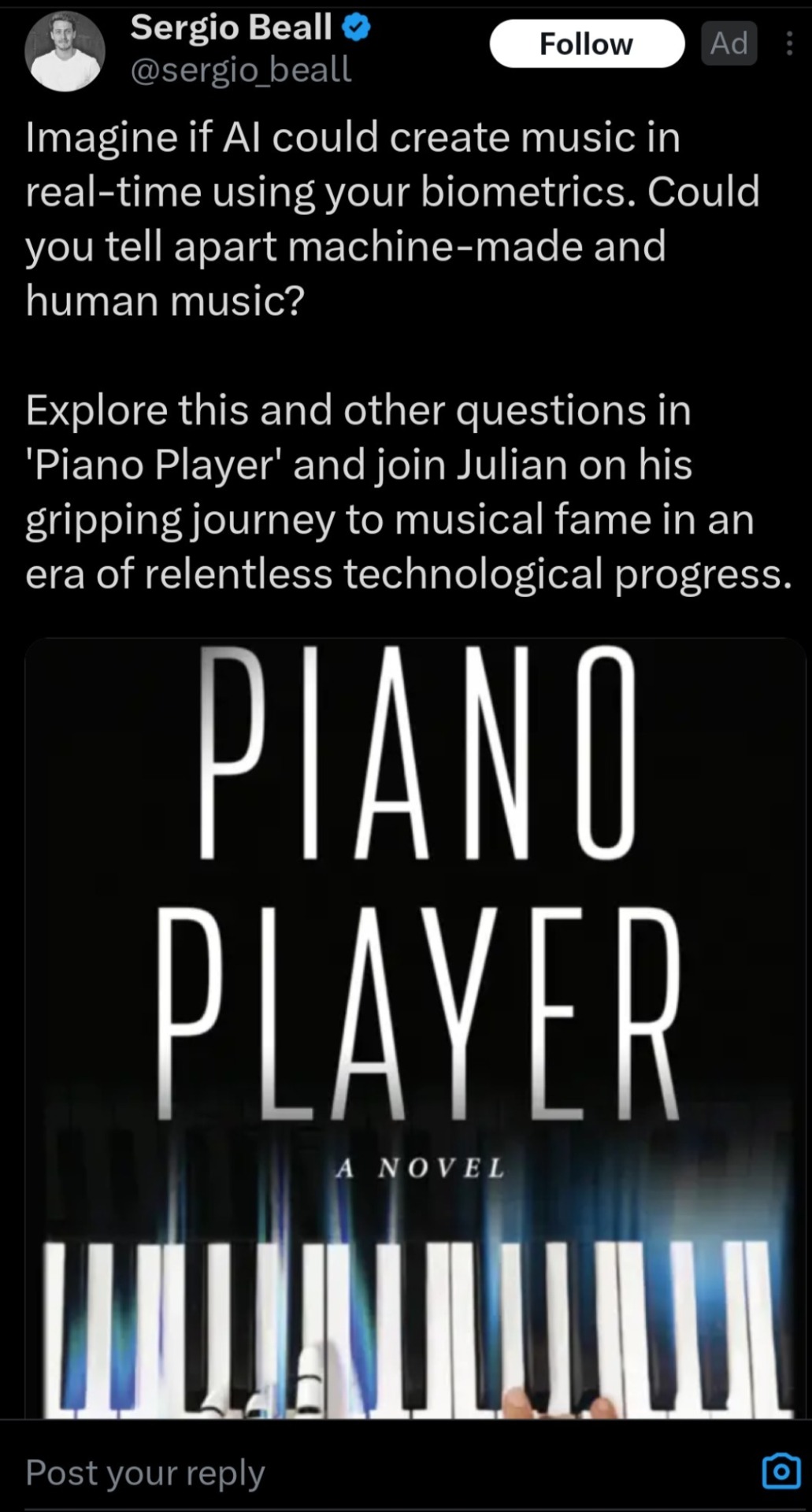
the first sentence reminds me of [The Who's] Pete Townshend's Lifehouse, still one of the most fascinating musical experiments i've ever read about.
i wish i knew about all that back when the Lifehouse Method website was a thing. for those unaware, it was a site created by Pete in conjunction with composer Lawrence Ball and software developer Dave Snowdon in which someone could input their personal data and generate "authentic musical 'portraits,'" pieces of music customized via algorithms that work based on whatever data you input. if you know anything about The Who, you'll probably recognize this as a facet of what would eventually become the album Who's Next, Lifehouse, a huge multimedia project involving a rock opera album, live performances with audience participation and complex tech on stage, a movie, who knows what else.
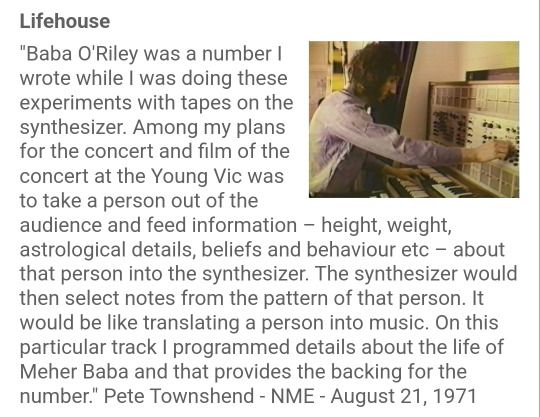
https://archive.is/8tYoM
i've always wished i could do one of these "musical portraits." i remember when I first heard about algorithmic (i refuse to call it AI because it isn't true AI) music generators, this was the first thing i thought of. back when they were in a rudimentary state, i played around with one for my own amusement (not for my own music, all that comes from my own head unfortunately for you), and while it was fascinating, it didn't go far enough in the direction i hoped. thinking of OpenAI's MuseNet, it takes a few notes worth of MIDI data & a style suggestion and then kinda randomly guesses what would be a good fit after those notes.

<image sourced from https://gigazine.net/gsc_news/en/20190426-muse-net>
and y'know, it makes for some fun meme videos:
youtube
youtube
youtube
<shoutout to the papaya>
but you can also see it only goes so far, and still requires musical input. it isn't quite on the level of being usable for much. and it really isn't quite the same. it's using inputted data, but not, say, biometric or biographical data. it's musical parameters that are being input as the data.
i really want to one day see a true realization of Lifehouse. one of my wildest goals is to be the one to do that. admittedly, i feel like in the current artistic climate the art world might no longer be ready for it; people would see it, instantly think "AI ART EW," and back away. but in this case, i don't feel like that's a fair assessment of what the concept is. the idea was to find each person's unique signature melody via these musical portraits. it isn't meant for anything really beyond personal identification, when it comes down to it. it fascinates me from a musical standpoint, and as a person who holds a psychology degree. imagine what someone can learn about oneself via this process! would your musical portrait be different at different points in your life? what could you tell about your personality from a single melody, or about your life history, or your beliefs and values? how would all of that reflect in your music? what genre is your soul? could a musical portrait truly capture any of that? with sufficiently advanced tech, sure, but idk if we're there yet.
heck imagine the therapeutic implications! imagine this tech being used in an art/music therapy setting, in which you work with a therapist to input your data, get a melody, and then use that melody with whatever form of musical expression you prefer (e.g. if you prefer to play the piano, guitar, a DAW, etc). what would you and your therapist be able to learn about you?
i truly do believe that, when it comes down to it, everyone has their own musical identification, "a song in their heart" if you will. i wish to expose people's hearts to get that music out, so that people may hopefully understand themselves better.
we might actually be at the level of tech necessary to truly realize a project like Lifehouse, but the tech isn't being used in this way. our current tech relies on predictive algorithms that kinda mostly draw on established musical forms, tradition, and there are only so many notes in the musical alphabet and only so many combinations and permutations thereof. a true realization of this tech would work, say, maybe in a similar way to how Pokémon speedrunners essentially break the game and essentially reprogram it to do what they want via a series of unexpected inputs. arbitrary code execution is what that's called, and i bet a similar function might help greatly in creating a uniquely generated musical portrait. because, when it comes down to it, are we not all Glitch Pokémon who cannot be contained by the boundaries of our programming?
youtube
anyway that was a long ramble. feel free to gimme feedback like you're a guitar held up to an amp or feedback like an echo chamber, whichever you prefer. this post idk if it'll make both pro & anti AI people mad or not, but that's what happens when your position on a thing is more complicated than a simple binary.
currently homeless still, so please help me if you can:
My partner's donate links are here: https://linktr.ee/IzukuLeeYoung. that's the best place you can send us money to keep us in our current hotel room and off the street.
https://odiohi.me/pages/product-categories - if you wanna help me by buying my wares (including my music)
To support me directly:
https://ko-fi.com/NoraQRosa
https://cash.app/NoraQRosa
https://patreon.com/NoraQRosa
#artistic musings#essay#“AI art” really isn't true AI. when we finally realize that true AI actually lives and exists among us...#...you know we're gonna see them take offense to how we currently talk about AI and algorithms and be very upset#people don't care because they don't see AI as people but as new slaves.#they don't want artificial intelligence. they want custom-made servants.#we aren't at a point where we see true AI making art#we only currently see uncreatives abusing algorithms and then going “look i did this” when all they did was type out a few words.#at least Lifehouse was for a purpose and not for techbros to use and abuse!#it actually has a fascinating concept that i fear has been corrupted in this day and age. we need to fix that.#homeless plural trans queer artist in need of dire mutual aid#Youtube
2 notes
·
View notes
Note
Hi! So i saw what you wrote about ai art, and fwiw, i don’t prefer it for that reason. I’m aware of the quality of ai art and I know it may sound cheesy, but it feels soulless. I can’t separate the art from the artist, and knowing it’s made by something artificial makes it feel like a mere shell. It feels hollow to look at. Knowing the story behind the artist, the passion they have, their personal style, pretty much all what they are as a person is what makes it special, fandom art or otherwise. Like, look at Starry Night for example. What if it were made by an ai? Yes it’s beautiful, and then what? The ai that made it can make a thousand more after it, it’s nothing special anymore. And there’s no story behind it, no value. Same thing with your works, knowing that you love these idiots as much as I do, seeing your attention to details and your own personal style and perspective are what really fascinate me. We love art because it makes us feel something, ai can only do half of that at best (for me personally at least). So personally, it’s the human aspect that makes me value art and want to own it. Sorry for the rant, but I just wanted to share my perspective as the viewer/audience :)
Oh, thank you! I think this is a compliment, so i will take it as one. :) Not really being an Artist, i honestly dont feel like my opinion matters too much in the debate? Like luckily or unluckily, i am not one of the many Many artists whose work is being sourced and stolen for this stuff. I am very angry on their behalf...i dont think any of the artists i follow are happy about AI art at all. It seems like a violation to me. They should be listened to over me and especially over the programmers/financial backers. (having a degree in art and computer science, I unfortunately am NOT surprised at programmers who think they are the only intelligence that matters in the world being happy to finally be cutting human beings out of the art equation)(they KNOW what they want, and the artist isnt smart enough to give it to them but THEY are smart enough to teach a computer to do it)(never underestimate the ego of a computer scientist)
Also as someone who was trained with a background in conceptual art, however, I find it fascinating. As a concept I think its cheap and quick, without a lot of depth. But then again so was the concept of art as an object vs statement of intent. The world of High Art hasn't really seen any big shakeups that are Popular, and i feel like this and n*f*t's might be the start of one of them? If i didn't despise the manufactured and classist nature of the Art World so much i might care more. But yeah, the conceptual art professors at my college are probably having a field day right now i would 100% love to sit in on that class just to learn.
#I just like drawing people and characters and i wish i was better at it :(#So that i might be worth something#I also probably have conflicted feelings over AI art because the art of john oliver and miss piggy was just too great#And ai john oliver art with anything is just the gift that keeps on giving
1 note
·
View note
Text
Handle With Care
Summary: For a moment, he considered walking back out of the room, give her the privacy she clearly desired, but she wasn't stopping, so he kept watching. She kept dancing to the delicate music and he sank to the floor in front of her, his legs crossed over themselves, a captive audience. Her lips quirked up into a smile, and as the song came to an end, she bowed in his direction.
TW: Nothing, so far as I’m aware. Let me know if you disagree.
Notes: This is part me being poetic and pretentious and part me being unable to get the image of Natasha dancing for Tony out of my head. I just, their relationship in the MCU is one I find fascinating. The "I should not care about you, but I can't help it" on both ends of that is something I can't help but play around with, and I've been toying with this fic for months and I'm not entirely happy with it, but I have it written so here. Cross-posted on AO3.
Human beings like to tell themselves such pretty lies. Things will get better. Everything happens for a reason. Love always wins. We tell ourselves stories where the good guys win and the bad guys get put away behind bars because we can't cope with the concept that sometimes, life just doesn't care. Tony Stark was born into a world that would always know his name, though not for the reasons he'd wish they would. Such careful manipulation of the facts made sure that no one would ever think that the man who was known as the Merchant of Death was so full of life and energy he was drowning in it. He poured all his passion into things he'd never publicize but they were his children; they were made of metal and code, but they were real and he loved them enough to hide them away from prying eyes. Act like you don't care about anything or anyone long enough and eventually, people stop caring about you.
Tony Stark was born a disappointment, and he learned early on that he'd be allowed more freedom if he didn't even try to change their minds. So he wore a mask made of recklessness and failure and watched as the world forgot that he was brilliant. The problem with masks is that some people will see them and decide it's far more interesting to see what they're hiding.
James Rhodes watched as the boy who was way too young to be sitting in the college lab twisted lines of code into a simple, but charming, personality like it was magic, then build it a body, sketching designs for the robotic arm over the blueprints his father wanted him to look over, just to see if his son had a mind for weapons as he did. James watched as Tony fixed all the issues his father's designs had, then go back to creating life like it was nothing special. James watched as his best friend was told his parents were dead and he watched as Tony shut himself off from the world and created JARVIS. It would occur to him later that AI was the first bit of armor Tony built.
Virginia Potts was the most terrifyingly competent person Tony had ever had the pleasure of being yelled at by. He had stumbled into her -- literally -- one night while leaving the R&D offices and she had given him hell for it, all while towering over him in her high heels, not a hair out of place. Her fury mixed with her composure startled a genuine laugh out of him. He promoted her on the spot. He liked the way she treated him as human, instead of a toy or a trophy. Things were easier with her at his side. The world didn't seem as overwhelming when she was there to take care of the practical things. She didn't judge him for having his head in the clouds, she just tied a string around his wrist and guided him like a balloon while she stayed firmly on the ground. It had taken him much too long to realize that there wasn't enough money in the world to keep someone with him, so her continued presence in his life had to be because she genuinely cared, and that was when he gave her the codes to his personal lab. He found her, his Pepper, asleep on the couch more than once, hair loose, feet curled up under a blanket she had brought down because she liked to watch him work.
One kidnapping and betrayal later, Tony began to distrust everything and anyone connected to his father. The only ones who actually seemed to care about him were the ones he chose himself.
Steve Rogers was everything everyone had wanted Tony to be and having all that rush back into his head out of nowhere put him on the defensive. He knew Pepper would tell him that none of that was Steve's fault and could he please get his head out of his head now? But he couldn't. This was the man that his father had idolized and searched for until the day he died. This was the man that Howard had poured all his time and energy into instead of his son, and while Tony knew, and he did know, that Rogers had no part of that, Tony was tired of the past coming to haunt him. Realistically, anyone his father had liked was bad news for him and there was no one, save Aunt Peggy, that Howard Stark liked more than Steve Rogers.
They clashed and shattered against each other, the whole world watching as Tony Stark and Steve Rogers fell into synchronization, the pieces of shared history falling to the wayside in the light of victory.
Natasha was difficult for Tony to process. She was the only person he'd ever met who wore as many masks as he did, and he tried desperately to not think about the fact that she was so deadly because of it. People underestimated her, didn't see how clever her eyes were, didn't see how she'd change everything about herself to fit the image they wanted to see. He saw how it wore her down. He could relate, and she knew it. It was strange, the art of being seen as what other people wanted shared between a man who was always in the spotlight and a woman who learned to blend into the background.
He liked to watch her dance. It wasn't that it made him forget that she was lethal -- quite the opposite, actually -- but more that she looked more human while she did. It was almost like whatever it was that allowed her to drift seamlessly between personalities melted away and left just a woman who loved to dance behind. She was talented and beautiful because of course, she was, but it was how carefree and unguarded she was as she twirled around that caught -- and held -- his attention. The funny thing is, he almost didn't have this, he almost let it slip through his fingers. The shooting range was originally going to be both Clint and Natasha's "welcome to the dysfunctional family" present, but the archer had a different idea.
"You want her happy, Stark, you give her a place to dance," Clint had said in such a no-nonsense tone that he almost thought that he was playing a prank on him, and if he followed through, she'd kill him without mercy. But the glint in Clint's eyes told him to take a chance, and so he lined one wall of the gym with mirrors and had a barre installed, much to the confusion of the builders. When he took all of them around the tower, the way her fingers trailed along the metal was reverent. She and Clint shared a look, he nodded, and suddenly Tony's arms were full of a redhead who could kill in an instant if she wanted.
"Thank you," she whispered into his ear. He's still not sure what platitudes he said, but a second later, she was across the room, no hint of the raw emotion she had just displayed on her face. And that was that.
He hadn't expected to ever see her actually use the space he had carved out for her, as it was well known that she was in the gym late at night when the more sensible members of their team had long since gone to sleep or pretended to. But he was no stranger to aimless insomnia, and had wandered into the gym one night, just walking around, and had been startled out of daydreams by slow music, and it would have been ethereal if not for the haunting melody. The sound of her feet hitting the floor came after and his eyes drifted to her. It was in that moment he had reconsidered the meaning of the word "revealing". He had certainly seen more of her skin than the leotard was showing, but he had never seen more of her. He looked so much like his father that they tended to forget that he was Maria's son as well. He'd been to enough ballet performances to know that while her movements weren't the most technically accurate, that was only because she didn't want them to be. He also knew she was aware of his presence. For a moment, he considered walking back out of the room, give her the privacy she clearly desired, but she wasn't stopping, so he kept watching. She kept dancing to the delicate music and he sank to the floor in front of her, his legs crossed over themselves, a captive audience. Her lips quirked up into a smile, and as the song came to an end, she bowed in his direction.
"You could do that professionally, you know. Drop the whole spy thing and just do that," he told her as she offered him her hand. She shook her head.
"No, I couldn't," she said. He looked her up and down, and smiled sadly.
"No, you couldn't," he agreed, "but you should dance for us, sometimes. Pretty sure that little number you just did would scandalize our dear captain." He wiggled his eyebrows and she laughed and laughed. Tony pulled her into him and began a simple waltz in the silence. She fell into step so effortlessly that it almost startled him, but only almost.
"Maybe I'll dance for everyone one day. We'll see. It's not personal, it's just," she sighed, unsure how to finish the sentence.
"It's just too personal," he suggested. She nodded. His hands on her body felt warm and distracting in a way she was not accustomed to. They were not wandering; they stayed exactly where they were supposed to be for the dance, and while his embrace was steady, it was not strict. She could walk away from this moment, and he would let her.
"I don't know how to let people in, Tony. I don't know how to be a person, not really." Her steps never faltered, but her voice wobbled, just a bit.
"One person at a time, one little truth at a time," he said, switching the dance from a formal ballroom to a playful mishmash of whatever he wanted. She grinned and teased him with chaos of her own. She twirled away from him, and as just as he pulled her back to him, he whispered into her ear, "and sometimes, Miss Rushman, you don't let them in at all. They come barging in anyway and you hope and pray they don't break your heart."
12 notes
·
View notes
Text
Alina Gray analysis
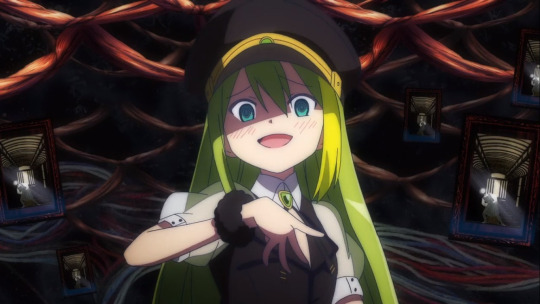
Well then, Alina Gray sure is a piece of work. The problematic fav of the MagiReco fandom, fondly referred to as psycho artist or JoJo reference. But Alina is more than a reference and more than just a psycho. In fact, is she even a psycho? In that case, psycho meaning either psychotic or psychopath (or I guess here psycho as in crazy murderous bitch). So let’s have a meaningful analysis of this character and undercover what might be a tragic tale of objectification.
We are introduced to Alina in the game in chapter 5 and in the anime in episode 9. In both media she arrives to stop the protagonists from destroying Ai, an uwasa. In the game, Madoka and Homura (Moemura) were there but not in the anime version. In the game, in her first appearance Alina appeared at first as serious, cold and irritable, before she revealed her mad and sadistic antics. In the anime, she showed up laughing maniacally, acting all eccentric and borderline insane, even strangling herself. It seems that the anime went overboard with the Alina acting crazy part. Not that I disliked it, but given that the game is the original source, I’ll keep this analysis mainly game-only.
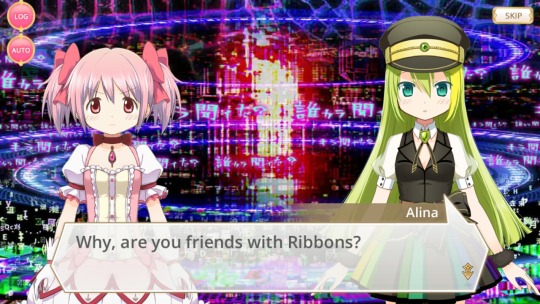

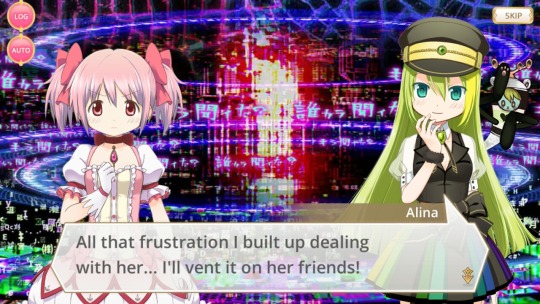
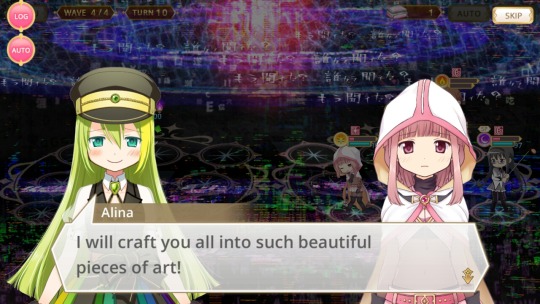

We should start by the beginning, which is Alina’s backstory as shown in her magical girl story. It’s implied that Alina’s fascination with life and death in her art started when her grandparents and dog died when she was a child. Given that this event was what drove Alina’s art, I’d say their death must have left a pretty big impact on her (especially since she was 8 years old and might not have been fully able to grasp the concept of death). Alina mentioned how her parents often got mad at her for spending too much time painting, which led her to make her wish to have a space when she can be alone and nobody can disturb her there. Alina was treated as an artist genius from a young age and gathered a lot of attention and big expectations and ended up having no privacy and being used for her talents by people around her, including her parents and teachers. Alina wasn’t valued as a person but only for her art and adults didn’t respect her privacy or free-will as they often shared personal information about her to the public or submit her arts without her authorization.
Despite being a famous artist, Alina shows no interest in popularity, admiration or love from people and simply wants to create more art. She doesn’t seem to enjoy attention or even the company of others and prefer to be left alone. No ones seem interested in how she feels, only in her art and how they can use it for their own benefit (like her teacher who submitted her art against her will and tried to force her to participate in other contests for the sake of the school’s reputation), and when she refuses she’s been called selfish. The only person who genuinely cares for Alina as a person is her kouhai Karin, but I’ll get back to their relationship later.
Her magical girl story shows Alina as someone pretty antisocial with mood swings and impulsivity issues where she can snap and result in material destruction. She seems relatively unhappy with her life and on the verge of depression. The breaking point was when she refused an award for a contest she didn’t agree to participate in in the first place, she received a letter from one of the judges: “It seems you are capable of creating a work that is so beautiful and arcane that viewers will think about it until their deaths. However, your work, which has no external theme, is a powerful drug that might drive people insane. That's why I want to tell you this. If you don't want to change the world, stop creating. You are only fifteen years old; if you haven't realized this, your brilliance will probably run out.”
I just want to mention first that the English translation doesn’t mention she’s 15 years old at that time (she’s 16 in the main story). At first, this letter may seem insignificant and harmless, until you realize how fucked up it is for an adult to say that to a teen. This judge said that Alina’s art is hollow and hurt people and that if she doesn’t intend to change the world with it, she should stop creating, and that her light will burn out. It basically implied that Alina creating art for herself is wrong and harmful and that if she isn’t creating for others, then her art is just worthless and so is her life. Again, implying Alina is a selfish person who is basically useless because she doesn’t want to meet people’s expectations and shaming her for that. Can we talk about how inappropriate, irresponsible and cruel it is for an adult to say that to a child? To crush their passion and treat its worth only by how others appreciate it? And the fact Alina was already feeling depressive before sure didn’t help.
Some people might think Alina is selfish, but let me tell you this: Alina doesn’t owe the world anything. Her art is hers and only hers, yet people kept trying to appropriate her art for their own goal, with no concern for how Alina felt, her desires, and basically treated her as a tool and used her. Now remembers, Alina started to show interest in art at 8 and in her magical story she was 15, meaning she went through 7 years of being used, guilt-tripped, having her privacy violated and having no free-will over her own creations. No wonder why she’s tired of people and just wants to be left alone, and is overall hostile to others.
After she received this letter, Alina became full of doubt and questioned the meaning of her art and life as well as her own worth, and came to the conclusion that just like her art, she’s worthless and is basically a poison and toxic to everyone. After leaving on a vacation to find some inspiration and a meaning to her art, in vain, Alina then decided that she would be better off ending all her art, as well as herself. She went on a rampage to destroy all her art before planning to commit suicide by jumping from a rooftop. She wanted her death to be her final work, concluding her art of life and death, so people can witness her last moment before her light fade away (she put a camera to record her suicide). A last desperate attempt to give some meaning to her life through death.
Kyubey did try to convince her to make a wish, twice, and the second time, Alina agreed, and wished for a space where she cannot be bothered by others. But she had no intent to play her role as a magical girl, she just wanted to add her wish in her life so it can be lost as well in her death.

Of course, as a magical girl, Alina survived the fall and encountered a witch, and, amazed by its beauty, found what the theme of her art was, what she wanted to convert to the world: Alina’s Beauty. She found a reason to live through that and a meaning to her art. She wants people to witness what she considers to be beautiful. And this is how she started to breed witches together and create even more powerful witches (again, let’s talk about that later). Interesting thing, Alina’s doppel is highly based on virus and poison that can drive people insane, which is a clear reference to her thinking her art is poison that drive people insane because of the judge.
So, what I got from her backstory is a subtle tragedy. Alina was basically objectified in a way since she’s a child, used for her talent and treated as a mere tool. Almost no one has any consideration for her feelings, desires and privacy and is, yeah, treated more like an object than a human, and put an insane amount of pressure by all the expectation and guilt-tripping people kept putting on her shoulders. Alina ended up with a disturbed sense of her own identity and what was the purpose of her life, splitting tendencies (incapacity how seeing both positive and negative, lack of nuance), impulsivity and recklessness, unstable and chaotic relationships, self-damaging behaviors, detachment from reality, as well as depression, anger and rage.
I might have sounded really precise here, right? Well, those descriptors I used for Alina are almost all the criteria for a specific disorder: Borderline Personality Disorder (BPD).
Yep, I’m basically saying that I think Alina might suffer from BPD. At first I thought she might be bipolar because of her mood swing between depression and almost manic behaviors, but bipolarity is mainly genetic and the mood switch is usually not that fast, unlike BPD. BPD is also a personality disorder, it’s not genetic and is caused by the environment, which makes more sense for Alina.
People with BPD also tend to be extremely sensitive to any form of criticism and alternating between idealization and devalorization and emotionally unstable and erratic. That sounds pretty much like what happened to Alina in her magical girl story if you think about it. BPD can also lead to psychotic episodes in more serious cases.
Now, I wouldn’t say that Alina perfectly fit the diagnosis or that it was the creator’s intention, but I feel like she’s a pretty good example of someone who suffers from untreated BPD and to me, it helps me understand the character on a more psychological basis and empathize with her.
There’s also more input on Alina’s psyche in the Holy Alina magical girl story. Again, after one critic that might look trivial from Karin (implying that Alina’s work isn’t art but breeding), Alina became overwhelmed with doubt regarding her art and extremely moody. Having her art compared to breeding and raising a pet deeply upset Alina, who’s forced to admit it’s true. She is indeed breeding witches, and she came to doubt that it’s real art.
Alina feels conflicted feelings. She’s mad that her art may not be art, but at the same time, feels excited at the idea of breeding witches, which only frustrated her even more. Surprisigly, it’s Karin who managed to make her feel better by making her read her favorite manga, bing worried that Alina might attempt suicide again. Alina understood through the manga that even if the plot is redundant, there’s a recurring theme that draws people to it. As a thanks, Alina bought a strawberry milk to Karin (while she usually stole it from her whenever she’s disappointed by her). Alina knows her art is more than just breeding and that she just need to find the core of her theme beyond life and death.
Alina decides to seek advice from her fellow Magius, Touka and Nemu. Nemu did notice how irritable Alina was these days. They make Alina realize that people tend to share a collective unconsciousness, like different civilizations worshipping the sun even though they had no contact with one another. So Alina needs to find something all humanity shares collectively, something she also shares with them. Touka suggested destruction: a death drive, a self-destructive urge. So the core of Alina’s art would be a craving towards death. After reading more about it, Alina became obsessed with the idea of self-destruction and, unable to fully grasp it, threw a tantrum and destroyed her atelier and aggressively asked Touka and Nemu for more explanation. Both explain how humans is one of the only species who kill one another even if it’s unnecessary, especially through wars. Mifuyu then arrives and complained that by destroying stuff, Alina is damaging the environment. This comment brought Touka and Nemu to find the perfect example of humans’ self-destruction: them destroying the environment. Not only are humans killing one another, they are also destroying their own planet.
Alina concluded that humans unconsciously crave death and destruction, leading them to their own destruction. She thinks this is why everyone is so fascinated by her art, because humans do seek their own death. Alina decides that she’ll indeed change the world with her art and that the core of her theme is “changing the world for the good of humanity”. Even if it sounds good, there’s something sinister behind this. For her, the “good of humanity” is granting what she thinks humans want: Their own destruction.
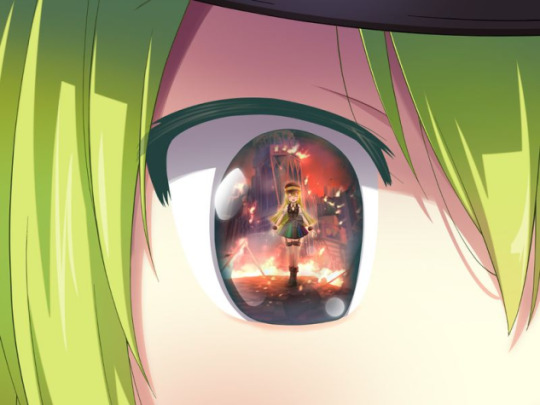
This is how she decided to become Holy Alina by wearing an Uwasa supposed to grant people their desires. And this is how Alina came to the conclusion she has to cause destruction, for the “sake” of humanity.

We might think that Alina’s actions actually came from a misguided good intention, but let’s not forget Alina is far from being a good person. She enjoys making people suffer and causing misery all around her, she doesn’t show any empathy for others and is remorseless. She’s sadistic, cruel and callous. And that lead to another diagnosis:
Antisocial Personality Disorder (ASPD).
In case you don’t know, ASPD is often referred to as sociopathy or psychopathy, even if both are technically incorrect, but let’s not dwell on that. Alina does exhibit a lot of antisocial behaviors, even before she became a magical girl, such as: Failure to obey laws and norms by engaging in behavior which results in criminal arrest, or would warrant criminal arrest, impulsive behaviors, irritability and aggression, disregard for her own safety and irresponsibility. She laters shows a blatant lack of remorse for her actions and a lack of empathy. The only traits she doesn’t seem to have is lying, deceiving and manipulating for her own profit or amusement. Alina is someone who is brutally honest and has no issue with speaking her mind and herself said that she doesn’t lie. I don’t recall any incident where Alina lies, but she can be deceiving and manipulative, like when she purposefully misled Madoka and Homura about Mami’s fate to hurt them, making it look like Mami met a gruesome death simply to make them suffer. But, ASPD can only be diagnosed when you’re 18 and alas, Alina is 16. But, there exists a precursor to ASPD for kids and teens, which is required to be diagnosed with ASPD: Conduct Disorder.

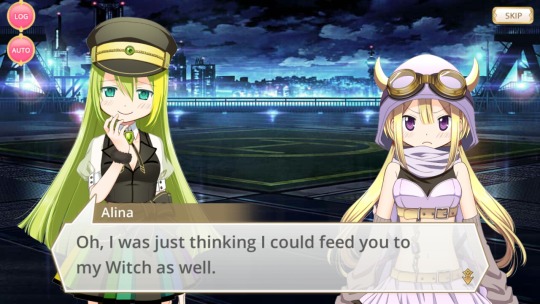
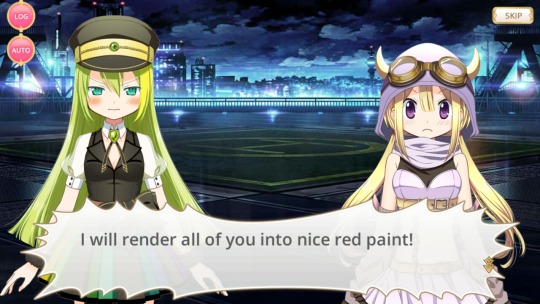
Alina almost fit the textbook criteria of conduct disorder. She’s a bully, aggressive, cruel towards others (and potentially animals), vandalism, deceptiveness and serious rules violation. And most of those were even before she became a magical girl. She often mistreats Karin and shows no respect for authority, she’s cruel towards others and I feel like it’s implied that Alina might have killed animals (and there’s also her reaction to Kyubey, who she thought was an animal and ended up kicking) and causes a lot of vandalism. Those were rather mild thoughts before she became a magical girl, where she’s downright dangerous and craving destruction.
BPD and ASPD both belong to the same cluster of personality disorder, cluster b, and are often comorbid. ASPD is often referred to as sociopathy, and given her borderline behaviors, Alina is pretty low-functioning. She’s impulsive, erratic and doesn’t bother to hide her true nature.
So, am I saying Alina is an irredeemable evil person who only seeks death and destruction? Yes, but no. There’s more to her. I won’t deny Alina’s cruelty and sadism and lack of concern for others well-being. After all, she doesn’t shy away from tormenting people, torture and attempted murder. But Alina isn’t born that way, she was driven to become a monster by the people around her. Alina wasn’t allowed to be a human, her feelings, desires and freedom were always disregarded, everything that makes someone human. Instead, she was treated like an object, an an object doesn’t have feelings and only serves a purpose. And the big tragedy in that is that Alina herself ended up objectifying herself. She decided to accomplish what she thinks humanity wants by causing destruction, but she’s also projecting her own self-destruction craving unto humanity as a whole. In the end, she tried to become the tool who will change the world for the good of humanity.
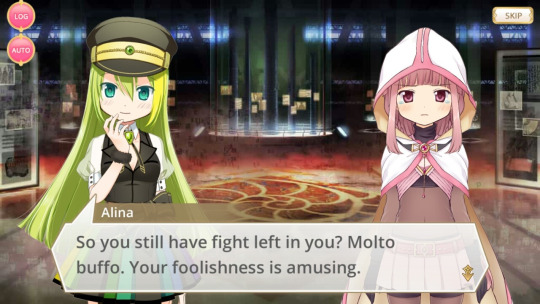

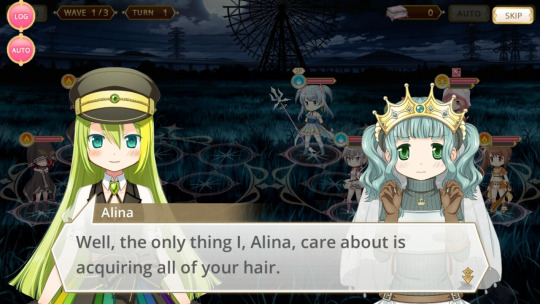
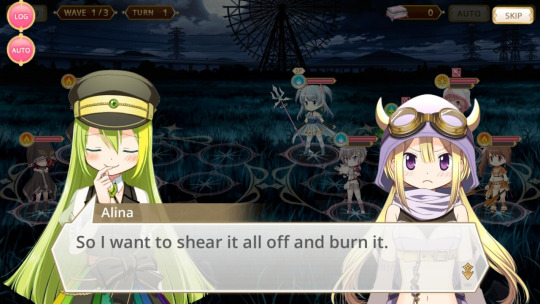
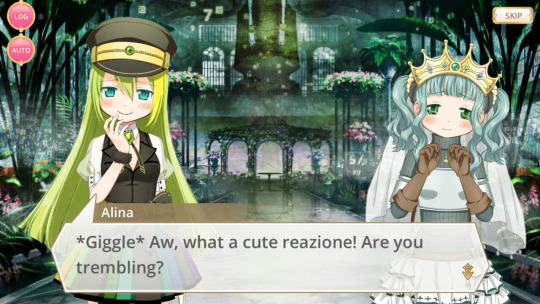
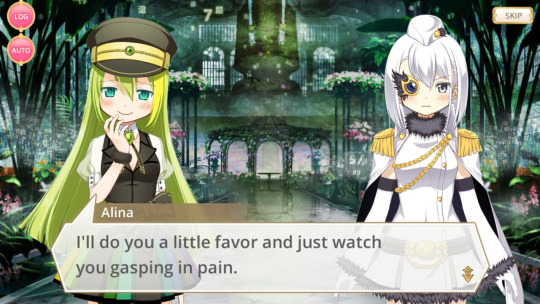

Being treated like an object made Alina unable to relate to others or understand their feelings, treating others just like she was treated: as objects. Alina seems to care for Mifuyu, but not as a person. Alina only values Mifuyu for her body, which she considers to be a work of art. Let’s not forget that magical girls’ true bodies are their soul gems and their human’s body is pretty much an empty shell, so Alina only caring for Mifuyu’s human body and not her as a person does show that she views Mifuyu as an object, not a person.
She also doesn’t understand humans’ bonds. When she proposed to spare their lives in exchange for Felicia (who she was angry at for destroying her witch), she didn’t understand why Tsuruno was so upset. Tsuruno even said “people aren’t objects!” which confused Alina even more. For Alina, everyone, including herself, are objects, and she herself can’t understand why others value people’s lives.
There’s also the way she’s treating witches. At first she seems to care about the witches she raised, considering like like pets and art and throwing a tantrum when Felicia destroyed one of them. But later in the story she shows no remorse to sacrifice the witches she raised, which shows that Alina doesn’t actually care for them, but given that they are hers, she can’t bear people other than her destroying them (or destroying them against her will). Alina did say that only an artist can destroy their own art. Given that she views the witches she raised and breed as her art, she doesn’t actually view them as actual pets but again, as objects. Alina’s objectification extend to witches too.
In one of the Christmas Events where she turned into Holy Alina, she ended up causing a lot of good actions while trying to do bad actions, which made people love her. But it didn’t please Alina at all. She doesn’t care about being loved or hated, she doesn’t care about what people think of her, good or bad actions. At some point, she noticed someone about to blow off a bomb and didn’t care nor show any interest in stopping him until she realized the bomb could damage Mifuyu’s body (again, she wasn’t worried for Mifuyu’s well-being, just her body). Alina seems to not feel shame for her behaviors, neither find it rewarding to be loved and praised.

Another thing regarding Mifuyu. At some point, the Magius (so Alina too) decided to sacrifice Mifuyu and feed her soul gem to Eve. I found it strange that Alina seemed to agree, until I realized something: A magical true body is their soul gem and they only need to feed that to Eve. There’s no need to feed Eve with their empty shell of an organic body. So I came to the conclusion that Alina didn’t mind sacrificing Mifuyu’s soul gem as long as she can keep her body. It just shows how much Alina doesn’t care about Mifuyu as a person and only valued her as a piece of art. An object. (And God knows what she would have done with her corpse).
Well, I’m not making a case about Alina not being an unredeemable piece of shit huh? Well, I decided to keep the best for the end: Her relationship with Karin.
It’s undeniable that Karin holds a special place in Alina’s heart (or whatever Alina has instead of a heart). Alina is cruel and mean towards Karin, true, but unlike other people, Alina never hurts Karin for her own pleasure or by sadism. Most of the time, she ended up mistreating Karin out of anger, mostly when she deemed that Karin made her lose her time or disappointed her, or when Karin is being dishonest with herself and doesn’t improve. Alina insults her and belittles her, as well as stealing her strawberry milk, not with the intention of hurting her, but as a form of punishment. Like a parent disciplining their child. But Alina does sincerely want Karin to improve and the fact that she takes the time to teach her, spend time with her and even rewards her proves that, in a way, Alina does care about Karin. In a really shitty and abusive way. But I don’t recall any instances where Alina physically harm Karin or show to enjoy hurting her. Still shitty and abusive, don’t get me wrong. But I feel like Alina is being abusive towards Karin because she’s unconsciously repeating how her parents may have treated her as a child. We know her parents often got angry at her and perhaps they acted in a way that is similar to how Alina treats Karin. The cycle of abuse sure is a tragic thing.
But why Karin? Well, I got a couple of theories. First, Karin is the only one who seems to care about Alina as a person and not an object. Karin greatly values Alina and is concerned about her feelings, something Alina isn’t used to, being only values for her talents. Karin often notices Alina’s change of mood and shows rejoice whenever Alina is in a good mood. She also worries greatly about Alina when she’s in a bad mood and even fear that she might try to commit suicide again. Karin is also someone who respects art and thrives to improve even if she seems to lack the talent. But she is still optimistic and never gives up, and she knows why she’s doing art. She wants to make people happy with her stories. Almost the opposite of Alina, who’s rather pessimistic, she oftens despaired regarding her art, she has the talent but lacks substance and doesn’t exactly know why she does art. Alina even admitted that Karin might be a bigger genius than her because of her passion, which Alina feels like she lacks, feeling empty inside. Even if Karin has expectations towards Alina, it doesn’t seem to put pressure on Alina, as Karin shows interest in how to make her own art and not Alina’s art itself. In a way, perhaps Alina can relate to Karin in a certain way, with her desire to make art, as well as being envious of how Karin can just be carefree about her art and be able to enjoy it without having people trying to use her. Perhaps this is why Alina is able to care about her, because in a way, she can relate to Karin. Still, Alina is abusive towards Karin and her intention doesn’t change how poorly she treats Karin.
Funny thing, Alina herself doesn’t seem to know exactly why she makes art, and ends up needing others' opinions to figure it out. She ended up deducing that her core theme is self-destruction because of Touka and Nemu, which seems to make sense with Alina’s fascination with life and death. People focus on the death aspect, but Karin thinks that Alina’s works are actually full of life. Perhaps Karin is the one who’s right, maybe Alina's actual core is more towards life, but given how twisted Alina became, she doesn’t even realize it herself. Maybe Karin is the only one who can see the good Alina might have deep down inside of her, or may even bring the good inside of her. Who knows, Karin might be the key for Alina potential redemption.
Also, it may not look like it, but I think Alina is constantly hurting inside, due to depression, but she’s so disconnected from her own feelings that she doesn’t realize it and unconsciously hurts others because she’s hurting. Alina is full of unhealthy coping. Her own fascination for life and death started by the death of her grandparents and dog when she was a kid, and might actually have traumatized her and her way to cope is her art. That would explain why Alina herself is uncertain about her theme, because often, understanding our own trauma can be quite hard, or even realize that we experience trauma in the first place. Perhaps death traumatized Alina and her art is her way to understand death better and accept it as a part of life itself. Maybe she actually wants to value life by understand death, because without death, life loses its core value.
So, did I answer the question? Is Alina a psycho crazy jojo villain? Yes, but no. Alina isn’t a psychopath and not downright psychotic either (even though she might experience psychotic episodes). Crazy? Well, I do think she suffers from personality disorders, but it doesn’t make her insane. A sociopath? Maaaybbeee. But to be honest, I mainly think Alina is someone broken who is the result of her environment, someone constantly hurting inside with deep self-destructive urges. The objectification made her feel disconnected from her feelings and humanity and turned her into a monster. But it doesn’t excuse her villainous actions, it only made them understandable and Alina more sympathetic.
Well that was longer than I expected. Let me know what you think and thanks for reading!
136 notes
·
View notes
Text
Meeting Bomg, Doom-Drone Legends from Ukraine
~Interview by Billy Goate~

Doomed & Stoned continues our week of epic interviews with a long overdue conversation with the great Ukraine doom-drone band BOMG, who have been desamating stages and blowing out amps since 2010. During that time, Nikolay Temchenko (guitar), Yuriy Temchenko (bass), and Anton Khomenko (drums) have put out two mammoth LPs, an EP, and a split.
I first got turned on to BOMG's sound with the record 'Polynseed' (2013), which released the year that Doomed & Stoned was founded. I recommend starting there if this is your first exposure to the mighty trio from Kyiv.
Bomg have been gradually drifting in the direction of full-on drone metal, executed in their own authentic and compelling way, as we're about to discover as we drill into 'Peregrination' (2020) -- which we reviewed last year and Robustfellow has recently reissued.
Give ear...
You state that BOMG means “vagabond” on your Bandcamp page. Can you elaborate on how the name ties in with the band’s history and core identity?
It’s an abbreviation literally meaning “with no particular place of living”. Funny thing is that its’ meaning is degraded in common use (like “bum”), but when it was incepted (60s – 70s in USSR) those who were stigmatized by it were better off going elsewhere than being part of the regime, taking it as a positive. This became somewhat of a short-lived movement even. We think that despite being prone to misunderstanding in every way, it fits the overall vibe. Blessing and a curse. But frankly, the name is a secondary thing at best.
How would you describe your distinctive sound, to someone who has never encountered it before?
Basically, trying to elaborate and add to “Black Sabbath spaghettified” idea. We try to squeeze out any possible amount of low frequency, volume, distortion and effect saturation to the instruments, not necessarily designed for it. As of similarities and influences, it’s 60s-70s heavy psych, proto-metal and proto-punk, 80s - 90s continuation of it (doom metal, stoner/desert rock, sludge, drone doom), besides that – dub, ambient, prog rock, experimental music, field recordings and whatnot.
Peregrination by Bomg
Your new album 'Peregrination' is an explosive bombshell, massive in every respect. When was the concept for the album born?
The first track was almost ready in 2011, we played it at our first show. As of concept, it started to take shape somewhere in 2013-2014, most of the lyrics were written back then. Then it took years to “grow.” First, we tried to make it so each track would fit one side of LP, but it seemed kinda compressed and landed too quick. Then we decided not to confine it to any time limit but each track landed itself around 40 minutes, so we made sure it evens out like this in final recording.
Tell us about the recording process involved. We’re very curious about instruments, gear, amps, and the general studio environment in which it originated.
Each whole track was recorded live (took roughly four weeks for four tracks), then layered with two additional guitars. Synths, field recordings, vocals were added afterward.
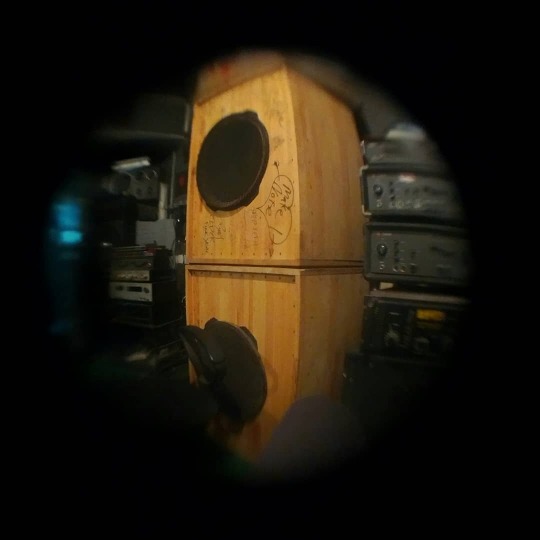
Gear: we used two Tank amps (Orange/Matamp clones) made from old soviet broadcast amplifiers and Tesla Disco 240 for guitar and bass (wish our Sunn concert bass was alive at that point, but it just burns transistors when turned on – we couldn’t find an exact schematic for it, even photos of the exact amp on the web, seems like it’s from some transition period).
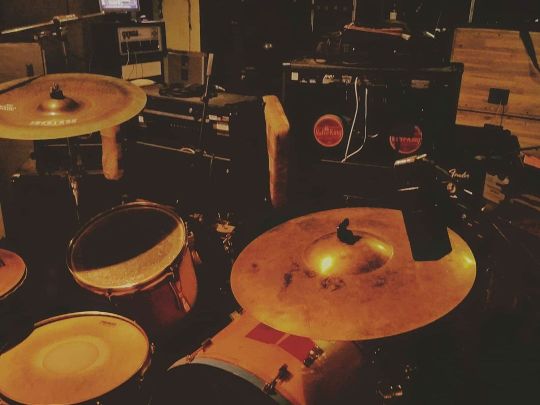
The drums are '70s Rogers 13”, 16” toms and 24” steel shell bass drum from '50s-'70s (mass-produced for political celebrations, weddings and funerals), coupled with Meinl hi-hats, Paiste Rude China and Zildjian Mega Bell.
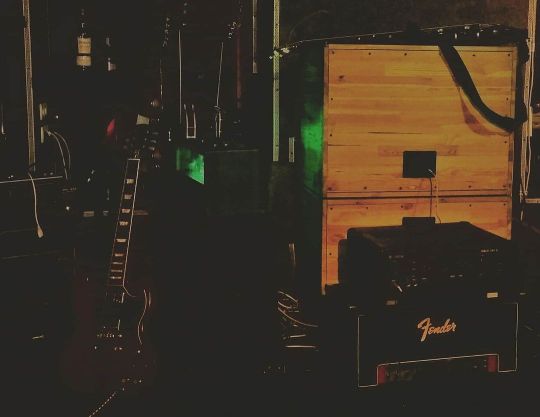
Guitars used were early '00s Gibson SG Standard, '72 Musima Eterna Deluxe and ’69 Musima Record; and ‘70 Cremona Violin bass.

Pedals: Poltava fuzz-wah, Noname “flanger” that is actually phaser for bass; Tesla Vrable fuzz-wah (the seller told us that his uncle was under KGB investigation for just having it), Noname dist (most likely a ProCo Rat clone), Vox wah, Boss BF-2, Lel’ parametric EQ, Lel’ digital delay, Boss dynamic wah, Roland Space Echo for guitar.
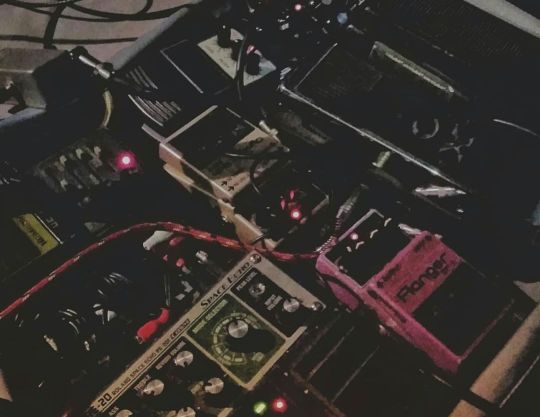
Recording equipment: Two '70s Oktava ML-19 for overheads, '50s-'60s Oktava ML15 and ML16 for room and various dynamic and condenser mics for everything else into Pro Tools, then later in mixing/mastering stage partly routed through mixer and cassette deck using beaten up cassette for analog saturation and vibrato.
Long story short, we tried to use most of the stuff we got in our studio, and at this point, it’s hard to remember every detail of the process. Referring to the environment, it is compiled of numerous weird gadgets which got to us throughout years, most of which were collecting dust somewhere for decades, and have a history (an entire topic by itself) we’re always asking for. And when used, they tell a story which then leaves a mark in recordings for sure. That was a hell of a fascinating process.

I noticed you had lyrics for each song on 'Peregrination,' but the singing doesn't seem discernable. Are there indeed vocals and, if so, how can I hear them?
Yes, there are vocals. They appear on low volume as reverberated and somewhat oscillated notes, more like presence; on high volume, you can hear words with 1-5 kHz correctly dialed in (on most audio equipment these frequencies tend to be excited, so lowering EQ at this range brings clarity), it appears as a whisper in a loud, saturated mix. Also, we added subtitles on YouTube, so you can know for sure where to find vocals. The point was to make them recognizable only with intent.
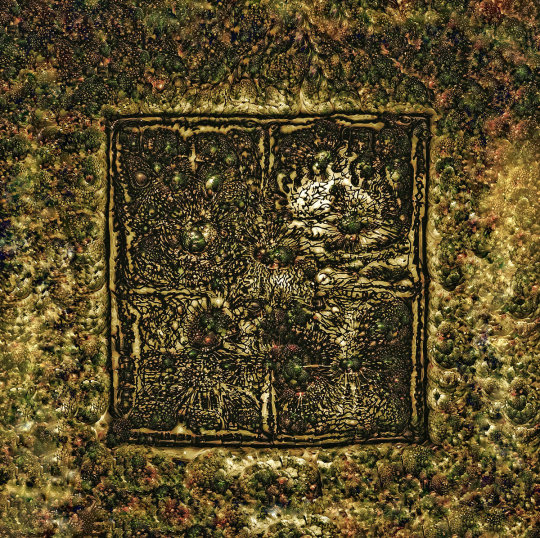
Talk about the album art. It seems there is hidden symbolism there, is that true?
It’s some sort of a window that leads to four areas, which are the visualized soundscapes to each track. There were no particular symbols, but the thing is that they fill in the picture as it is set - like a hallucination, which is often a well of meaning where symbols change and multiply interpretations, at the same time being just momentary blobs of form.
The process of making this album cover involved many iterations of drawing, running through GAN networks, editing the result to achieve the effect of a captured hallucination, close to the exact one. When hardwiring symbols directly into it, they would be eaten up by hallucinating AI. So by randomly forming a resemblance of shapes, things started popping out where they fit the most contextually - weird stuff. It’s a common thing in art to throw “open for interpretation” on everything, but this one might be.
What is the concept behind each "hobo" symbol and track on 'Peregrination'?
So, the first one means being quiet and alert, seeing what’s going on. The second one is a sign of a trolley – hopping from one soundscape to another, time travel. The third one – safe camp; it may be confusing when applied to the lyrics, but the position that is stated there facing the object is some sort of a “safe camp”, ground to stand on. The fourth one means “don’t give up”, even if applied in both meanings of this phrase to track. But the symbol references may lack context without diving into tracks.

I'm sure our readers would be most happy if you were to illuminate the meaning of each of the songs on your new album.
Well, it’s like trying to create a soundtrack to some introductory ontological theories (pretty blank, sterile stuff), realizing their intensity. Here uneven-numbered tracks touch on mind ontology, even-numbered - on reality ontology. Not diving into details too much, let them hang there.
I. Electron
Peregrination by Bomg
it's no light of star
it's a light of mind
walking thru a dream
electron shamanism
"Electron" is covering the theme of mythical perception akin to humans and the discovery that put a dent into these beliefs. Variation on a Tunguska story, mythos surrounding Tesla, how people mythologize all around.
II. Perpetuum
Peregrination by Bomg
Across desolations
Caravans astray
Sand covered roads
Forget old ways
"Perpetuum" goes more into sci-fi territory: endless cycles of dead and born-again civilizations, the Great Filter caused by cosmic events or beings themselves, and how we just might unknowingly observe such things staring at the sky.
III. Paradigm
Peregrination by Bomg
Giant web built and set in lines
It works when mind reflects
Leaving us with all the fears
Or letting them disappear
"Paradigm" is based around the tendency of the mind to confine itself into some set of ideas, building a higher fence while thinking it broadens the space. Thinking of one thing while it is the opposite, fear of the structure collapsing while an event like this would alleviate any sort of fear. But breaking a paradigm usually leads straight to the next one, to which the same attributes apply. And keeping this notion brings a safe distance to it.
IV. Emanation
Peregrination by Bomg
Now the opportunity is
To see the universe spinning
Emit structures boundless
Round its' endless borders
It's the very first the very last small moment
In periods of endless time
When the structure merge infinite
To manifest as something
"Emanation" goes somewhat contrary to the second one - a reality that may be started at some point, complicates itself, and never is truly repetitive. Also thoughts on subjective existence and the point of it, maybe being an instrument of the Universe to explain it to itself. Speculation on whether or not consciousness flows from one state to another, as energy does, returning to its inception or scattering across until equilibrium, or even said results being the same thing. And the uncertainty of these things that are left to be answered while we as beings, it seems, are just left to fade away.
Follow The Band
Get Their Music
#D&S Interviews#BOMG#Kyiv#Ukraine#doom#metal#doom metal#drone#sludge#atmospheric doom#Robustfellow#Doomed and Stoned
6 notes
·
View notes
Text
AI: The Somnium Files review
While it wasn’t the first visual novel series I played, the Zero Escape trilogy- Nine Hours, Nine Persons, Nine Doors, Virtue’s Last Reward, and Zero Time Dilemma- is what made me interested in exploring more visual novels in general. Featuring a creative mix of normal visual novel sections and puzzle room sections, with stories involving fascinating pseudo science theories, colorful and interesting characters, fast, tense pacing, and great music, the series is an insane adventure that’s absolutely worth a try. The series also got me interested in the other works of Kotaro Uchikoshi, the director and writer of the series, which led me to the subject of today’s review, and his most recent work: AI: The Somnium Files, which proves to be quite the change of pace, to say the least.

Story:
Kaname Date is a member of the Advanced Brain Investigation Squad (ABIS), a special, secret division of the Metropolitan Police Department. Using a device known as the Psync Machine, Date can explore the subconscious of another person by entering their Somnium, a dream world which often holds secrets they would not reveal otherwise. 6 years ago, Date lost his left eye and all of his memories, left with no link to his past, not even his real name, except for Boss, his superior in ABIS and longtime friend. His left eye was replaced by an advanced AI called Aiba, capable of functions such as night vision and x-ray, as well as serving as Date’s avatar within Somnium.

One gloomy November night, Date is called in to investigate a murder victim found in an abandoned amusement park, having suffered multiple stab wounds, tied to a merry-go-horse and missing her left eyeball. The victim is Shoko Nadami, an acquaintance of Date’s, and the ex-wife of Renju Okiura, Date’s best friend and president of the entertainment company Lemniscate. Date’s initial investigation proves unfruitful, and comes to a halt completely when he discovers someone within the merry-go-round’s central column, traumatized to the point of being unable to speak and cradling a bloody ice pick: Mizuki Okiura, the 12 year old daughter of Shoko and Renju, whom Date took into his care 4 years ago.

Date continues the investigation the days afterwards, meeting Mizuki’s friends, the internet idol Iris Sagan, aka A-Set, and the otaku and aspiring light novel author Ota Matshushita, Iris’ mother Hitomi, and Moma Kumakura, leader of the Kumakura yakuza gang. Though Date finds a number of odd connections and occurrences, such as Renju falling out of contact, a call from a mysterious prisoner only known as #89, who claims to know the identity of the killer, and a large number of incidents among the Sagans, the Kumakuras, and others, all of which seem to date back to 6 years ago, he finds little in the way of actual evidence. Left with no other recourse, Date begins to Psync with both suspects and witnesses in the hopes of preventing the killer from striking again.

While it’s a fairly standard plot on the surface, it’s very well done nonetheless. The various mysteries and plotlines are all compelling, and are all given a good amount of focus. Adding to this is the use of a route system, similar to Zero Escape, complete with a flowchart allowing you to easily go to any point in the story. Completing certain Somniums in different ways alters the course of Date’s investigation, causing certain plotlines and characters to gain or lose relevance depending on the route. While every route needs to be completed, each one containing their own reveals and clues, there’s only 5 in total, making keeping track of the distinctive events in each fairly simple. The pacing is also well done, taking its time and allowing you to get used to the characters, while throwing just enough new hints throughout to keep it interesting.

Speaking of the characters, the cast is easily my favorite part of the game. The characters are very, odd and colorful, pretty much to be expected from Uchikoshi. Date himself is a pretty entertaining protagonist, with a tendency for perversion, making bad puns, and coming up with very odd and often ineffectual ideas for progressing in Somnium, going against his serious demeanor and appearance. The supporting cast doesn’t slack either. From the rational, yet sassy Aiba, who turns much sillier within Somnium as well, to the peppy and friendly Iris, to the playful Boss, whose office is an absolute mess decorated with just about any nonsense you could imagine, to my favorite of the cast, Mizuki, the mature, sarcastic, and inexplicably strong kid who spends a good deal of her time arguing with the rather distant Date. It’s hard to dislike most of the characters, with even the most minor of them being good for a laugh or two.

That’s not to say they’re just goofy, though. Almost everyone carries some sort of baggage or secret with that adds a good deal of depth to them, and the various routes give them a lot of development. The game can be pretty damn emotional at points, and the routes focusing more on the characters than the story are the biggest source of them, especially Mizuki’s route. The lighter tone the game takes most of the time actually helps this. Most of the time, interacting with random objects trigger dumb jokes and commentary from Date and the others, and the relaxed pacing and atmosphere, at least earlier on, make it easier to get gradually attached to the cast. Once things do become more serious, the game starts cutting down the jokes, and stops them outright for the most serious of scenarios, meaning it rarely actually becomes jarring. It’s not often a game can juggle a tone as well as this one.

Overall, the writing of the game is superb, and while it’s quite different in tone and setting, it still has enough of the feel of Zero Escape to feel familiar to those who played it.

Gameplay:
While I call AI: The Somnium Files a visual novel just for the sake of simplicity, it definitely more has the feel of an adventure game. There’s two types of gameplay segments, investigations and Somniums. During investigations, Date travels to various locations, talking with various characters or investigating important object. Your only control here is controlling Date’s view, and selecting different dialogue options or objects to investigate. Date often has to investigate several locations during a segment, and while you often have to visit them all, you’re given the freedom of picking where to go in whatever order you choose most of the time, giving just enough nonlinearity to not feel like a chore.

The real meat of the gameplay takes place during the Somnium sections, which are comparable to the escape rooms in Zero Escape. Within Somnium, Date and Aiba must break the various mental locks the information they are seeking are hidden behind, which involves interacting with various objects according to the logic of each Somnium. Basically, they’re purely logic puzzles, and it’s actually quite fun figuring out how everything is supposed to work.

Of course, not everything can be that easy. Every Somnium has a hard time limit of 6 minutes. Going over it causes Date’s consciousness to be absorbed into the subject’s, causing a game over. All interactions also cost time, and many incorrect decisions can drain your time pretty significantly. Thankfully, the game has many mitigating factors that keep this from just being stressful. Firstly, time only drains when you’re making choices, or actually moving around. Standing still causes only milliseconds to pass, allowing you to get a clear look around without wasting time. Additionally, all objects you can interact with have a purple outline surrounding them, and are given name tags as well, meaning you don’t have to just wander around, running up to every object in the hopes this one is usable. Not every interactable object actually has a purpose, however, with some only existing to waste your time, so you’re not completely in the clear. The progress meter on the left also gives hints, if sometimes vague ones, as to what you have to do to progress, so you’re not just fumbling in the dark in that regard, either.

Another important feature at the TIMIEs, objects you gain when you interact with objects. These cut the time actions take to perform by varying amounts, or make it take a fixed amount of time. Good use of TIMIEs can save you a lot of time, and a lot of later Sominums enforce it, making it rather strategic. Sometimes, just rushing to the correct solution burns way too much time on its own. You may have to do something you know is wrong, but takes little time and grants a good TIMIE, to be able to save more time on a much costlier action. This aspect isn’t entirely simple either, however. Not all actions display what kind of TIMIE you’ll get, making it a gamble at times, and some, including mandatory actions, give negative TIMIEs, that actually increase the amount of time an action will take, and force you to use them the action after you get them, often forcing you to do something incorrect, but with low time cost, just so you won’t game over.
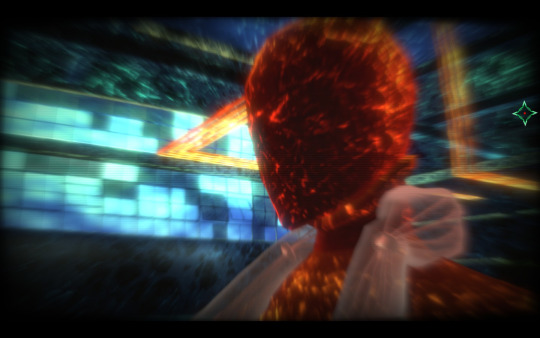
Each Somnium also has two conditions that unlock album entries, which provide pictures and concept art. The first is for clearing a Somnium with more than 1 second left, as you’re actually allowed to go over the time limit if the final correct action is what pushes you over. The second is for finding special eye shaped items within the Somniums, which are often hidden out of the way. Finally, even if you’re struggling with certain sections, you’re granted 3 retries per Somnium, which allow you to return to a previous part of the section, with all the time you had left at that time, allowing you to optimize and save even more time, though it costs more retries the further back you go. Finally, even if you can’t win, you can simply restart the Somnium section with no penalty, and are even allowed to do so at any time in the menu. Overall, the Somnium sections are actually a lot of fun. Between the interesting logic and strategicness of it, not to mention some of the funniest dialogue in the game between Date and Aiba, they’re some of the most enjoyable parts of the game.
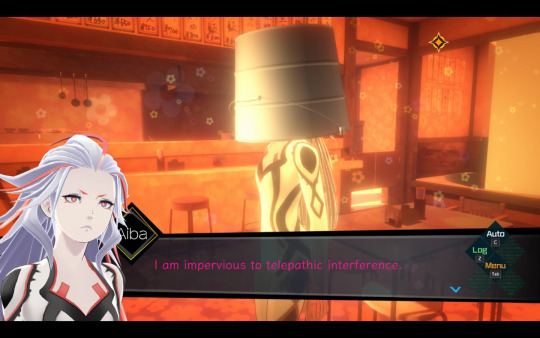
Finally, the game features a few “action segments” during the investigation segments, where Date will be faced with an actual physical threat. Aiba formulates plans to deal with the situation, and you just need to handle each step by pressing a button prompt, like a QTE, or hovering the cursor over a certain area for a long enough time. It’s not exactly difficult, but they serve their purpose. There’s also a few interrogations segments, where you must present relevant evidence to someone in order to prove a point. You can just randomly pick until you get the right one with no in game penalty, but there are achievements for clearing these sections and the action sections with no mistakes.

Graphics:
AI: The Sominum Files is a surprisingly pretty game. It has a similar art style to Zero Time Dilemma, which, to put it bluntly, was downright awful in the visuals department, with unemotive character models and terrible animations that killed almost all of its attempts at being unsettling. While a few of the animations in this game can still look janky, it is on a whole much. much improved. The characters are much more expressive, helped by the designs by Yusuke Kozaki, best known for games like No More Heroes and Fire Emblem Awakening, fitting the style much better, while still being distinctive in their own right. The locations have a lot of detail to them, and the lighting is very well done. The highlight of the visuals, though, are the Somniums, which manage to give existing locations very distinctive, well, dream like qualities to them, such as shifting colors or heavy lighting, and are always a joy to explore.




Sound:
AI features a downright fantastic soundtrack by Keisuke Ito. It manages to capture a similar feel to Zero Escape’s music at points, despite being a different composer, but still manages to stand out. Every song manages to fit the situation perfectly, while also being very catchy on their own, especially the Somnium themes. The music, combined with the visuals, give the game a very strong atmosphere. Whatever mood the game is attempting to set, nostalgic, tense, peaceful, or unsettling, it nails it very, very well, and had me immersed very easily.

The game also features some fantastic English voice acting. Greg Chun as Date and Erika Harlacher as Aiba are the main stars of the show, with their performances capturing their characters perfectly, but the rest of the cast is just as good. Jackie Lastra as Iris, Zach Aguilar as Ota, Corina Boettger as Mizuki, Allegra Clark as Boss, Kaiji Tang as Moma, pretty much everyone does a great job.

Conclusion:
Overall, AI: The Somnium Files is something I highly recommend to most people, even those who haven’t touched another Uchikoshi game. It’s a fascinating, emotional, and satisfying experience that successfully manages to devote attention to just about everything it brings up, and doesn’t overstay its welcome. Honestly, I enjoyed it even more than any Zero Escape game, and considered I still look on those very fondly, that’s an achievement.
With that, this review finally comes to a close. I shall likely be checking out the games Uchikoshi worked on before even Zero Escape: Never 7, Ever 17, and Remember 11. Till next time.
-Scout
30 notes
·
View notes
Text
Notes From the 2020 Myanimelist.net Challenges - Part 2: Manga
Time for Part 2 of the Thoughts on the Challenge posts; this one talking about the manga side.
A lot of the executive dysfunction and side effects of the chemo kinda took away my desire to read sometimes. As such, I didn’t get as far into the challenge as I had hoped, only getting about halfway through the required amount I had chosen for myself. There were even a few manga I was reading for the challenge that I have unfortunately not yet finished (Billy Bat, Battle Angel Alita, Meteor Methuselah), so I reluctantly won’t be including them on here. However, I did still read and finish some decent manga and some pretty good ones, too.
Like the anime post, I will mention some honorable mentions/one I had thoughts on, followed by my favorites that I read for the challenge this year.
Let’s do this.
Honorable Mentions/Other Notables:
Scumbag Loser (aka Saiteihen no Otoko) - completed for the task “Read a manga series you can finish in one day”
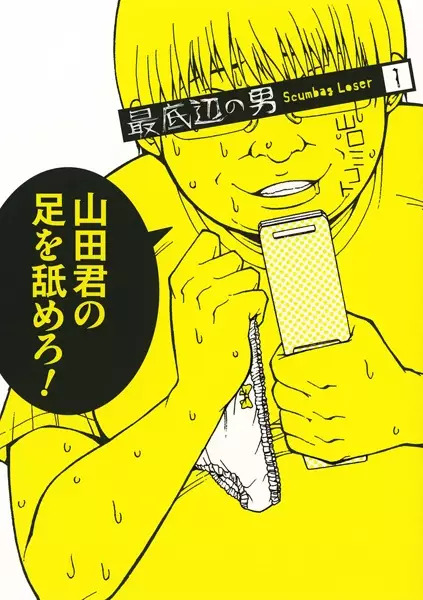
Masahiko is a fat, perverted loser who has a smell fetish and thinks everyone is beneath him. He takes solace in the fact that he’s not the Class Loser. However, when the Class Loser gets a girlfriend, Masahiko becomes the new Class Loser. Desperate to get out of this position, he lies and says he has a girlfriend: his childhood friend Haruka, who transfers to his class the next day. But there’s a problem that only Masahiko knows: Haruka died several years before.
This wins Worst of the Challenge, but I didn’t hate it entirely. Masahiko is not a good person, which is usually a negative in my book. This manga basically goes from 0 to 100 real fast. It takes a couple unexpected turns and I couldn’t help but wonder how the problem would be stopped. Ends on a bit of a downer.
Dragon Head - completed for the task “Read a manga that started serialization in the 90s”

While on a school field trip, the train carrying the students crashes after a natural disaster. Teru is the only survivor in his class. While trying to find a way out, he finds two other survivors, Ako and Nobuo. The three survivors try to escape while dealing with lack of food and light, earthquakes, cults, and the freaking apocalypse happening outside.
This manga was quite the ride. Creepy and scary at times. The artwork was really good, definitely adding to the atmosphere. I liked the characters. The story did kinda drag a bit in the middle and I felt the ending was kinda rushed and stopped inconclusively, but I liked this one.
Omukae Desu - completed for the task “Read a manga that started publishing the same month and year as one of your listed favorites” (Azumanga Daioh, in this case)

Madoka is a college student who has the power to see lost souls, kinda like the Ghost Whisperer. He is recruited by Nabeshima (the guy in the bunny suit on the manga cover) to work for the GSG, an organization that helps transport wandering souls to the afterlife. In order to help, Madoka often lets the souls briefly take over his body to do various things that they always wanted to do before passing on.
This manga was actually pretty adorable at times. Lighthearted and fun. Characters are kinda hit-and-miss, though their interactions are very amusing. I liked it.
Deathtopia - completed for the task “Read a manga that got cancelled/axed”

Kou Fujimura is an average guy. One day, he gets into an accident and is severely injured, leaving him blind and on the brink of death. He gets surgery and survives, but he now has psychic abilities and can see weird monsters. A mysterious woman appears, and she recruits him to help her and her fellow hot assassins who work for the police department. He helps the ladies take out the aforementioned weird monsters called Cheaters, people who come back from the dead with special abilities and blend in with normal people.
I liked the story/concept a lot. Kinda gave me Parasyte vibes at times. A little bit too fanservice-y at times. Very good in the beginning, but took a lot of lapses in logic (pointed out in the scanlations I read) near the end, and the ending felt rushed, though I can blame that on the manga being prematurely cancelled. I still recommend this one, as the story is interesting and the action is good.
The!! Beach Stars - completed for the task “Read a manga with a symbol in the title”

The sequel to the manga Beach Stars that I read for last year’s challenge.
Iruka and the rest of the team are back, getting ready for and competing in the Madonna Cup. Iruka’s goal is still the same: to beat the local volleyball champ Sanae Kayakawa.
Everything I liked about the prequel is here. The action/sports scenes are great, and the camaraderie between the ladies is cool, too. Though it is disappointing that this sequel is only 12 or 13 chapters, as some things could have used more buildup and fleshing out, especially the final match. Still a fun read, though.
Favorites from the Challenge:
Watashitachi no Shiawase na Jikan (aka Our Happy Time) - completed for the task “Read a featured manga” (Article: https://myanimelist.net/featured/1561/11_Epic_Manga_That_Deserve_to_Be_Adapted_into_Anime)

Juri is a former pianist who has gone down a dark path after a traumatic event in her life. She has grown to hate her mother, who was once a famous pianist herself. Juri has since attempted suicide multiple times. Yuu is a convict on death row charged with murder, and he has tried to kill himself as well. When Juri’s aunt Monica, a nun, invites her to visit Yuu, their lives both change forever.
This manga makes me think of how a friend told me they recently saw the movie Collateral Beauty for the first time. They said it was melodramatic, but they cried and enjoyed the movie all the same. This pretty much sums up how I felt about this manga.
This one honestly made me tear up a bit, as melodramatic as it was. A little dark, but I was still invested in the characters and the situations. The art is really good, too. It’s one volume, so it doesn’t take that long to read.
Kingyosou - completed for the task “Read a manga that includes a character with a disability”

One day, a girl, Asuka, falls in love with a boy, Manami, after hearing him play the taiko drums at a school festival. Manami is deaf, however, and has closed his heart to love. Asuka and Manami get to know each other and face various obstacles in their relationship, both relating and not relating to Manami’s deafness.
I thought this manga was really sweet. I also liked that there was deaf representation here, though I can’t really speak on how accurate it is because I’m not deaf myself. You don’t see many manga where the characters have disabilities. The relationship felt a little more realistic in this one because it took some time (as proportional as time can take in a 2-volume manga) for Manami and Asuka to get into the relationship. Another manga that was short, sweet, and to the point, at only 2 volumes.
Babel - completed for the task “Read a manga that appears when putting in your username in the Myanimelist search bar”
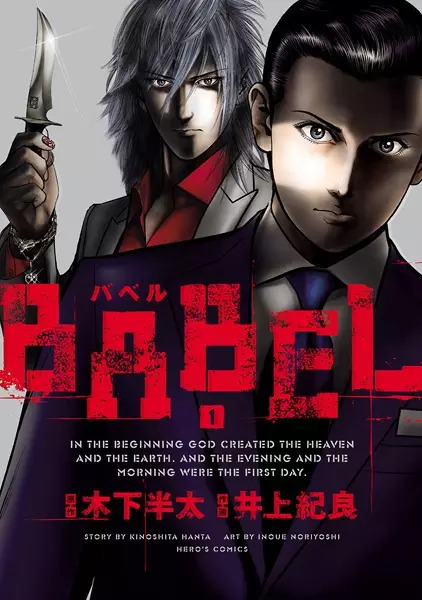
Kouta is a hotel waiter dissatisfied with his job serving rich clientele on New Year’s Eve at the Babel Hotel. On New Year’s Day, a worldwide terrorist attack occurs, with bombs going off everywhere. Kouta then meets someone who gives him the ability to go back in time. Kouta has to use this ability to stop the terrorist attack from happening and pretty much causing WW3.
I liked this manga a lot. A lot of unexpected plot twists. A fascinating mystery, keeps you hooked. I’ve always found time travel plots to be interesting as well.
Bloom Into You (aka Yagate Kimi ni Naru) - completed for the task “Read a Shounen Ai or Shoujo Ai manga” (tagged Shoujo Ai)
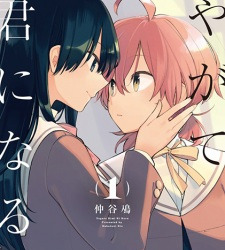
Yuu is a new high school freshman who loves romance manga and wants to experience a love story of her own. But when a classmate confesses his feelings to her, Yuu finds she feels nothing. Yuu sees the student council president, Nanami, turning down a love confession herself. Yuu joins the student council and she and Nanami become friends. Nanami soon confesses her feelings for Yuu, and Yuu is confused.
This one is tied with the next entry in this post for Best of the Challenge.
I loved this manga. So sweet and adorable. Made me tear up at times. Great, well-written character development. Doesn’t rely on bad/problematic tropes like certain other yuri I’ve read and watched recently. I loved watching this complex and realistic relationship between Yuu and Nanami develop. Some of Yuu’s feelings are pretty relatable. Read this one if you’re looking for a great yuri manga.
Inside Mari (aka Boku wa Mari no Naka) - completed for the task “Read a Psychological or Thriller manga” (tagged Psychological)

Isao Komori is a shut-in who spends his time after dropping out of college fapping, playing video games, and visiting a local convenience store every night to see a high school girl named Mari, who he admires from afar. One day, Isao finds that he is in Mari’s body! Isao-as-Mari continues to live her life and tries to find out how to switch back.
I know I mentioned this earlier, but I’ll be giving Best of the Challenge to both Bloom Into You and Inside Mari. I honestly couldn’t decide between the two, as they are from two different subgenres and two different styles. Kinda like how I couldn’t decide between Hereditary and Into the Spiderverse as my favorite movie of 2018 because they were so different form each other that I couldn’t really compare them.
This manga threw me for a loop multiple times. A subversion and deconstruction of the usual body-swap plots. A darker take on one, if you will. A couple of interesting plot twists, and the manga often takes a different direction than you expect, especially about halfway through the manga, where it switches to different characters’ points of view.
Highly recommended, though not for everyone.
#manga#myanimelist#myanimelist.net#scumbag loser#saiteihen no otoko#dragon head#omukae desu#deathtopia#the!! beach stars#the beach stars#Watashitachi no Shiawase na Jikan#kingyosou#babel#bloom into you#yagate kimi ni naru#inside mari#boku wa mari no naka#thoughts of the day
2 notes
·
View notes
Text
When The Best You Can Do Is Shoot A Gun
The Animal Crossing / Doom Eternal Covid19 launch coincidentally seems to be related to this discussion, even tho I’d say Doom Eternal has an excellent combat system and isn’t really relevant to what I’m going to bring up. I don’t have a problem with shooty-shooty, I have purchased, played and will continue to purchase and play plenty of video games that engage with firearm violence. There are plenty of discussions about how intelligent, consenting adults can do this without any problems and I won’t retread them here. Doom is simple game themed vaguely around demons; demons bad, player protagonist good, good player shoot bad demons - OK you got it, apply an incredible movement system into that and enjoy.
What I want to discuss involves of-course that pesky word and idea nuance, which annoys the shit out of more people these days, for its applications and misapplications - fingers-crossed I don’t fuck it up, but first I want to bring up Ubisoft and systems, so now’s as good a place as any for a stolen picture from the internet.
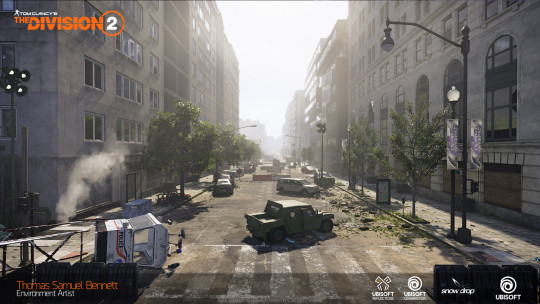
As far as concept art goes, that’s actually very representative of the final product in-game.
Ubisoft appear to have a long-term open-world tech development objective. I believe at some point very soon, these individual objectives will converge into one single middleware product with a mandate to producce retail licenses that combine what each of these individual franchises have been testing and achieving in isolation, those being;
Ghost Recon Wildlands and Breakpoint: 3rd person Load-On-Demand
The Division: 3rd Person Cover and interactivity
Assassin’s Creed: Environmental mapping and interactivity
Starlink: Scaling Load-On-Demand
Far Cry: First Person implementation of various combinations of above
I’ll put it another way;
Ghost Recon: Load everything
The Division: stick to everything
Assassin’s Creed: climb everything
Starlink: scale everything
Far Cry: do it in first person perspective
It looks like all of these games are running in Ubisoft in-house proprietary engines. Ghost Recon and Assassin’s Creed are running in Anvil, developed for the very first Assassin’s game and in which the Prince of Persia 2008 and Forgotten Sands also ran in. Oddly, (Rainbow Six) Seige, Steep (lol) and For Honor are also running in Anvil.
Both Division games and Starlink are running in Snowdrop and this appears to be due to The Division having come from Massive Entertainment. I’ll be honest, from the perspective of a consumer (read: punter) and someone with extremely minimal 3rd-hand development experience, The Division looks far more impressive than both the Ghost Recon and Assasin’s games, and former Massive brand and art director Rodrigo Cortes has said of the engine that it was design to “do things better not bigger” and I think it shows. Anyway, it was still developed with Ubisoft so as I understand it, they own it. Massive is a Ubisoft subsidiary, their studio based in Sweden.
Far Cry is going to be a little different, being a little older and having its roots slightly before... what shall we call this mess... the cynical age? The microtransaciton age? Anyway. The first game used the CryEngine developed by Crytek. At some point, Ubisoft seemed to develop an offshoot of the engine called Dunia because the CryEngine was licensed and clearly lucrative, I think. I’m not entirely sure, but Dunia does appear to remain in-house and under the auspices of Ubisoft Montreal. Where am I going with all this?
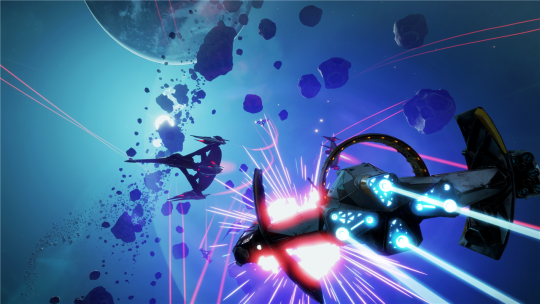
Starlink was “toys to life” a-la Skylanders but way too late, combined with No Man’s Sky-lite, but the game itself other than being overstuffed with Ubisoft copy-and-paste template-quests is an excellent proof of concept.
I do need to say that in general, I don’t have any particular affinity for Ubisoft. So I am yes, absolutely fascinated with something I do think is happening as far as tech goes and now I’m writing about it in this piece, and yes you can tell I’ve played and even enjoyed some of the games they’ve produced and published, but there’s a lot not to like about many of their practices, the least of which is the overbearing sense of cynicism pervasive in many of their games.
I played Far Cry 3 long after it released and got perhaps 20% thru the campaign before giving up entirely. For starters, nothing about how it controlled felt right and I appreciate that’s purely a personal preference. Being a Battlefield player, there’s something about DICE’s sense of locomotion that is perfect to me, even tho it varies from title to title from Bad Company 2 all the way to V most recently. Other things about Far Cry bother me tho - if there’s wildlife around, it always attacks the player, guaranteed. Everything about this game seems to be designed to force the player into engagement, to provide you with materials to collect, craft or sell, but also to run you short of ammunition to either scrounge for more or have to buy it because *surprise* - it prompts you to purchase ammunition for real-world money. ARE YOU FUCKING KIDDING ME? Fuck off. I uninstalled the game immediately. I can deal with ridiculous AI with magical aim and irrational scripting. I can deal with absurd narrative for the sake of reading (and roasting later), but the entire package culminating in purchasing more ammunition was otherworldly, it was truly bizarre. To this day, I don’t understand what world Ubisoft inhabits that this is something that makes sense to anyone in management or marketing, and yet there it is and there are consumers that not only accept it but embrace it. No doubt there are metrics from the mobile industry that support it and dear lord the capitalist apocalypse is upon us.
What will Ubisoft do when they can merge these technologies? They definitely want to and likely already have in-house, they just need the engine to run client-side for the Consumer. You and I and Inside Gaming are all laughing it up at Stadia right now, but we’re at the wrong end of the business. For Ubisoft, they can ignore the faltering at the start, it’s the long-term they focus on. The pittance Google are losing now, even if they end-up shuttering the project will be meaningless if they end-up getting the hardware to work, even if the end-result is the hardware sitting in a box in the consumer’s home in 10 years. Sure, that’s a long loop, but the journey still doesn’t matter, only the eventual ROI.
If this piece hasn’t gotten boring for you yet, it’s about to because you’re probably excited for what Ubisoft will do with this impending technological power and development and I rally am not. What will Ubisoft do with it? Probably just more Assassin’s Creed, except you’ll be able to snap to cover and have a fully mapped country. Probably more The Division, but you’ll have a fully mapped city that you can also climb on the outside of buildings and then enter them without any loading. Probably more Far Cry but with bigger maps and more interactivity and less loading. The next generation of consumer hardware consoles from Microsoft and Sony are upon us and as much as PC enthusiasts hate to admit it, the consumer market is largely gated by the generational hardware stepping of these platforms. That may change after this era depending on how Google, Amazon and indeed Microsoft and Sony go with cloud computing, but for the moment the status-quo will remain as alternative products develop. Bear in mind with Covid19, climate change and the general sustainability and ethical standards of working and living being under growing scrutiny the world over, things are changing more each day, our technology development may change in ways we don’t expect so who even knows what’s in store for the future.
So What Do I Actually Want?
Good question.
NB: before you ask, Animal Crossing isn’t my thing. I played it years ago on Gamecube. It’s cute, it’s fine. I’ve no interest in it. I’m writing this note in retrospect because I realise you may say “Just play Animal Crossing or The Sims but hopefully I can illustrate by neither of those games is what I’m after, nor do I just want to build a house in something like No Man’s Sky and fill it with crap. Let’s see if I get there...
A few weeks ago I wrote about how the best thing Naughty Dog did with Uncharted 4 was Elena and Nathan’s domestic spaces. I did purchase The Division 2 on the cheap a couple of weeks ago and I’ll be honest, there’s a lot about it that I’m enjoying quite a bit. For a start, visually it’s stunning. The art team have done an excellent job of both filling the world with immense detail, but also making every area of Washington unique and distinct which is a huge feat given the total space covered. Thus far, I’ve spent a whole lot of time just walking around and gathering resources, in part just to sightsee and explore without any particular objective in mind. After a while, I got the impression that the map was a bit flat, but the more you explore, the more you find places where you get verticality, and then doing missions always adds verticality and variety in environmental and art design, it’s a marvel to see.
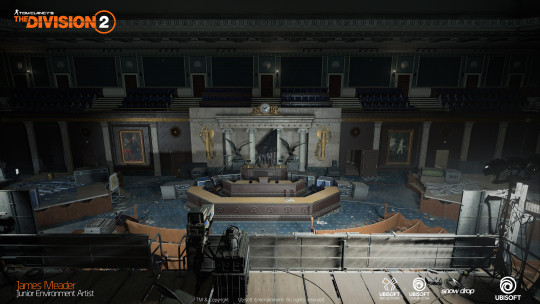
Apologies to James and Thomas (above) for ripping these images, but I’m glad your names are in frame so you have direct credit - outstanding work. The art in this game is without question its strongest element.
And that’s just the thing - The Division is an interesting game in that what I enjoy most is the sense of walking around exploring, gather resources and helping people. I’m not here on an anti-violence kick - I play Battlefield, I actually don’t mind the shooting in The Division, it’s fine, whatever, I’m not going to justify that. What I’m saying is that it gets boring.
THERE ARE A LOT OF GAMES ABOUT SHOOTING.
Like... a lot. More than enough. There will always be a lot of games about shooting and that’s fine. I think I’ll always play them. Hey, I even play games about shooting *in very specific ways* - it’s not like I don’t care about the shooting, I’m playing The Division with only a bullpup DMR and shotgun combo, plus I’m trying to use my sidearm when traversing the streets as much as possible so don’t at me, I’m in the game.
But we seem to mostly get high detail assets in games with guns because shooty games get all the money. I get it - shooty games get all the sales because we as gamers like to play them - sure, I’m one of them, but I didn’t buy The Division until it was under AUD$30 because gotdam the shooting is so boring and even now yes, it really do be just more boring shooting, just like it’s boring in Uncharted, just like it’s boring in Ghost Recon (my goooooood so boring), just like it is in Destiny, and the umpteenth shooty mcshooty game. I’m getting too old for this.
Uncharted 4 had an opportunity to do something more and it almost did. For many players, it probably achieved enough of what I was after by those two visits to the Fisher and North residences but I wanted so much more of that. I want to see Sully’s house or houses, more of his life. I want to know where Chloe’s life is at. I want to know of their lives and emotional engagements outside of the frankly stupid narrative I have no interest in because it’s clearly stupid and an excuse for running and jumping that other games have since done better. If Uncharted as a whole was a subtext for character, then by the fourth game, the focus should have been the characters that carried the series thru to the end - no disrespect to Tom Baker - not the heretofore unrevealed older brother.
For Years I Didn’t Know “Walking Simulator” Was A Pejorative
I think this is why I replayed and continue to replay Dear Ester so much. I remember laughing my ass off at YouTubers making videos about how it wasn’t a game and that it didn’t have objectives. Yet there were still threads and might still be on reddit or Discord wherever gamers congregate these days - about “virtual tourism” and “just chillin’ in place x because it’s so awesome” etc. It’s fine, each generation will rediscover virtual tourism again and again and we can’t denigrate anyone for doing so, it’s certainly nothing we invented given it comes from literature and oral tradition before that, but it’s remarkable that there’s this resistance to experiences crafted purely for the purposes of being immersed in them.
I adore Dear Ester and Everybody’s Gone To The Rapture. Absolutely loved What Remains Of Edith Finch and only if you have already played Edith Finch, because it’s full of spoilers but also its own spoiler warnings, I heartily recommend Joseph Anderson’s outstanding video The Villain of Edith Finch. It’s a 53 minute watch so I won’t embed it, and he has a certain style of presentation that won’t gel with everyone, nor do I always agree with everything he says which should go without saying but at some point folks, you have to stop pursuing art, criticism and media that just wholly aligns with your own views. That said, I generally do find most of what he says agreeable, innit. Anyway he’s great and the video is great.

While Dear Esther is more surreal and Rapture and Edith Finch are in part slightly more fantastical than the real-life settings of Uncharted 4′s home and Division’s post-apocalyptic cities, they all visually represent dense, very human object-rich spaces that to me are quite interesting to explore. Dear Esther might be a little more rooted in nature but its human elements tie-in to its narrative in an extremely interesting way. Each game offers different levels of interaction, some that serve the narrative directly, some as subtexts and others quite mildly in the periphery.
I’m sorry if I’m repeating myself but I remember seeing a promo for Battlefield Hardline coming off the back of Battlefield 4 and the ridiculous marketing phrase “levolution” - the term they coined for large-scale environmental destruction (please take the keys away from the marketing department). I remember seeing video footage of a large construction crane falling in a level and thinking
“All this intelligence, all this tech, and this is what we do with it? Is this all we can achieve? This is it?”
That’s how I feel about this emerging technology.
Somewhere out there (on YouTube, to be fair), there’s all this footage buried of the Beyond Good And Evil sequel that to everyone’s knowledge is still in development. I’d put my money on that being the first project built in Ubisoft’s convergence engine that they hope successfully implements everything that each of these games executes individually. I know the BG&E fans are frothing for it and when I saw those early demos, what I interpret of the tech did blow me away, but from an experience perspective, I did still think the same thing...
“Is this it?”
Because of-course, a huge part of the new game is going to be combat.
I just - don’t - care.
When I think about what was lacking in Uncharted 4, what I wanted more of, it was intimacy. What didn’t I like about the conversation and resolution between Elena and Nathan? About the tours of their homes, the little time spent playing as Cassie, the few insights into Sully as a character, the absence of Chloe who was such a great contrast to Nathan, Elena and Sully all-together... it was intimacy. Yea oroight, so I don’t exactly mean the type of real-life intimacy between lovers, do I - that much is clear. But if I don’t mean shooty because there’s enough of that, and I’m leaning into domestic detail and emotional exploration and reflections of that in objects, spaces and interactivity, then that’s what I mean.
Tho I’m loath to bring it up, I feel like in the worst possible way, David Cage is right on the periphery of this discussion (and for that reason, I ain’t tagging him or his games in this entry, get fucked). He has the most vague notion of trying to ground his games in the intimacy of human experience, so he tries to tie human locomotion and objects to the digital representations of interactivity. If we take those as perhaps the worst possible examples and then come back to some really good examples in Uncharted 4 so I can stop whipping it - I maintain that the house tours are strengths and the high-points of the game, and then look at something like The Division and consider opportunities for more complex interactivity centred around helping people and emotional engagement, I feel like that’s what I’m after.
Which is impossible, right? No-one’s going to make a game even a quarter of the scope of The Division, with all that amazing dynamic lighting, with all those awesome textures and mapped objects, animations, rigged character models, complex scripting and AI, interactivity, load-on-demand tech and full voice-talented support, just to be a game about exploring, sightseeing, meeting and learning about people and helping them? Because who would play that?
I would, for a start.
#video games#videogames#better start taging in the single word version#ubisoft#ghost recon#the division#assassin's creed#starlink#far cry#video game development#Dear Ester#What Remains Of Edith Finch#Joseph Anderson#Beyond Good And Evil#Uncharted#Uncharted 4#Battlefield#Levolution#game development#chrono#2020#housekeepingtags#writing about games#writing about video games#writing about videogames
5 notes
·
View notes
Text
The Role of “Hate” in Pluto
I have just finished Pluto and one of the things I found the most interesting about it is how it explores the concept of “hate”.
The ending is very clear in its condemnation of it:
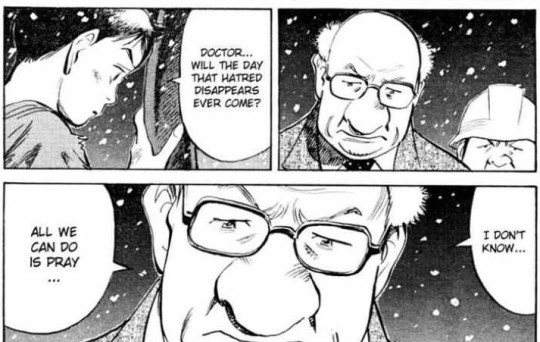
However, more than this, what I find fascinating is how the story arrives to this point and what this conclusion means. As a matter of fact hate and other negative emotions like sadness, anger and grief are all portrayed as very human emotions which are very common and difficult to avoid. So, this meta will try to explore this idea further.
Pluto is a retelling of one of Osamu Tezuka’s stories which is called The Greatest Robot on Earth.
Because of this, I think that a good way to go at it when analysing it is to ask ourselves what the greatest robot on Earth should be like.
This is professor Tenma’s answer:
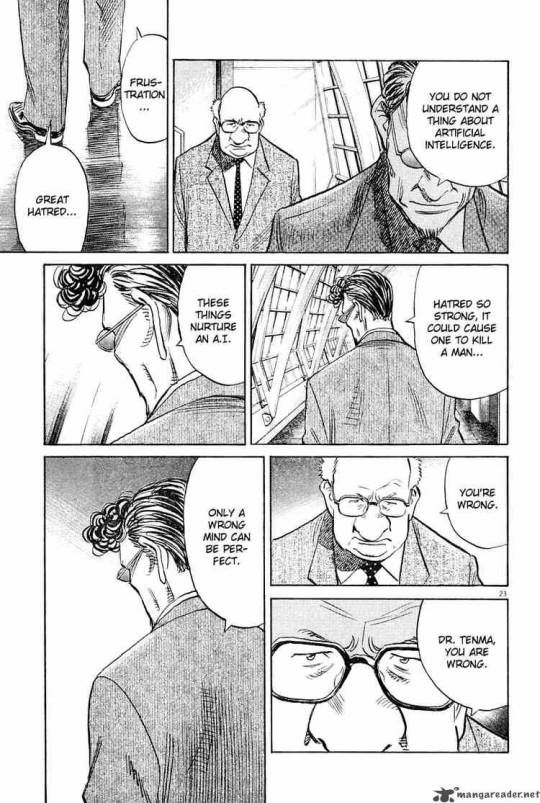
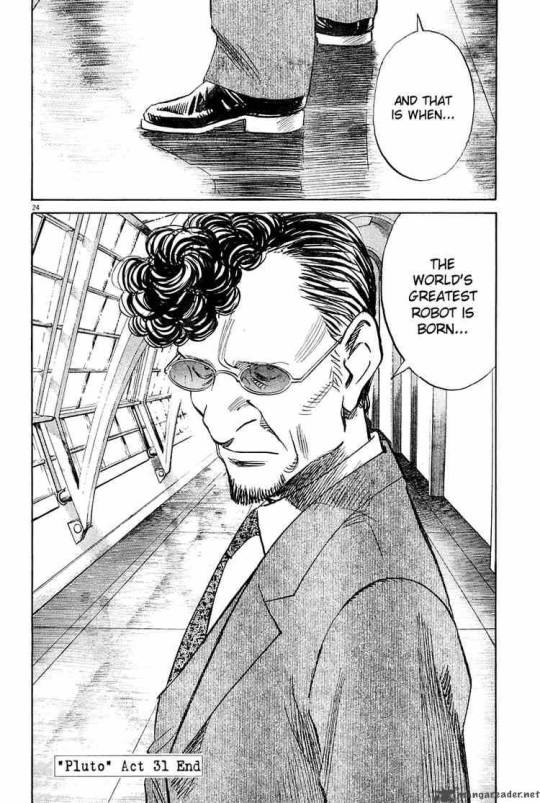
As a scientist Tenma wants to recreate human nature through an AI. Humans hate, feel sadness and lie, so a perfect robot should be able to do these things as well.
Let’s underline that this idea which is fully expressed by Tenma is prepared throughout the narration in several ways far before Tenma makes it explicit.
For example, Brau 1589 states that no malfunction has been found in his AI. This is because him killing a person does not make him less perfect, but actually better than other robots because it makes him closer to a human. This is once again clarified by Tenma when he visits the robot:
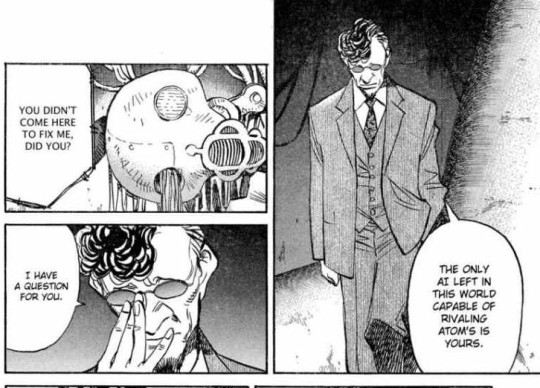
Similarly, Atom says something interesting here:


On a less darker note, the narrative offers several examples of minor human weaknesses robots are not supposed to share:
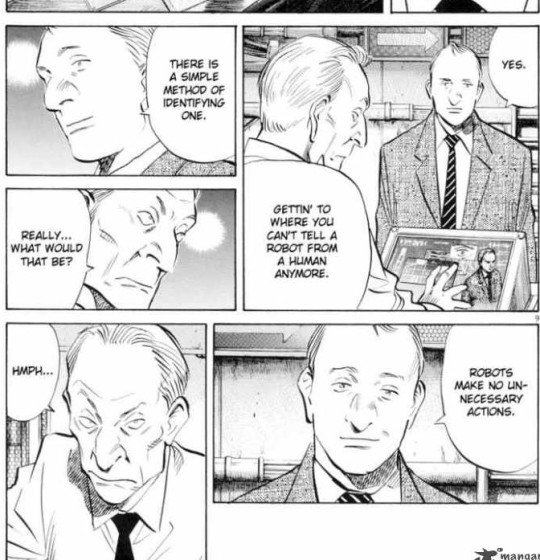
In a conversation he has with Gesicht, Hoffman states jokingly how a robot who skips work could be considered progress. This is perfectly coherent with the ideals embodied by professor Tenma’s character.
This idea might seem to endorse a pretty negative perspective of human nature. This is certainly partially true given Tenma’s cynism and his status as a person who has escaped from society and so who avoids interactions with other human beings as much as possible.
However, when it comes to Tenma, I think that what he thinks about hate and human imperfection is something a little more complex than that:
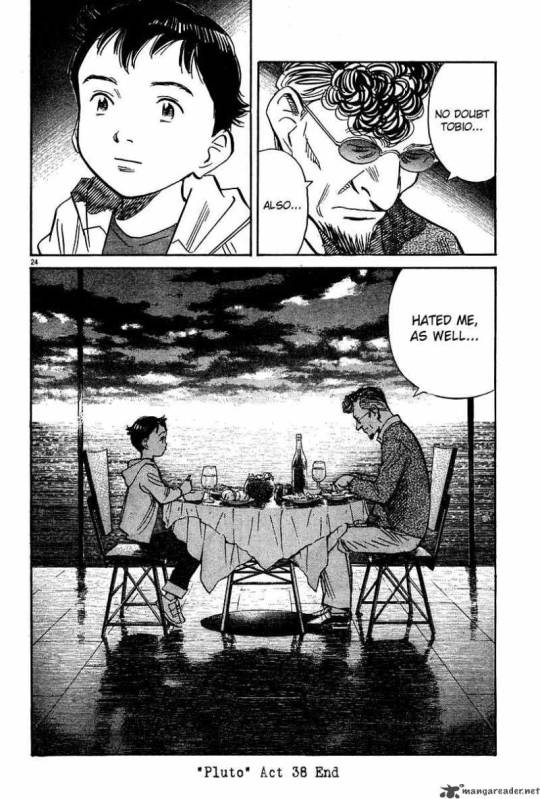
Tenma created Atom to somehow “resurrect” his son who died in a car accident. However, he soon realized that Atom was not Tobio. First of all he does not mature like human children do:
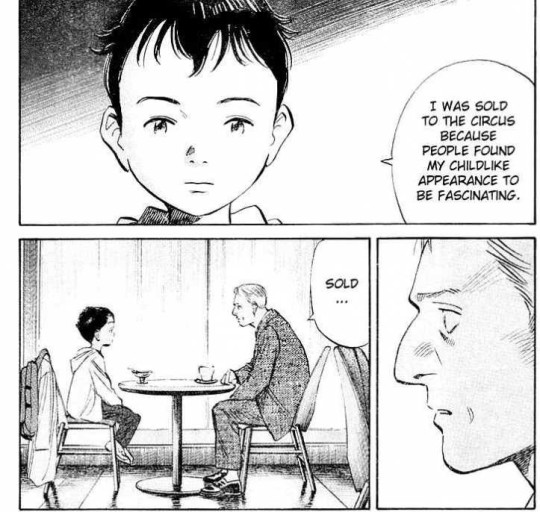
Secondly he doesn’t share Tobio’s feelings and imperfection. He can try to imitate them, but when it comes to a feeling as complex as the one of hate he doesn’t know what to reply to Tenma.
So, for Tenma the negative traits which made Tobio human are the ones he misses the most and Atom lacking them is why he decides to sell him and to leave him behind.
This is to highlight how Tenma’s vision of the world is not simply one driven by scientific curiousity and a sense of nihilism. Those two are aspects definately present in him and they make up a great part of his personality, but they are rooted in Tobio’s death and in Tenma’s inability to overcome grief:
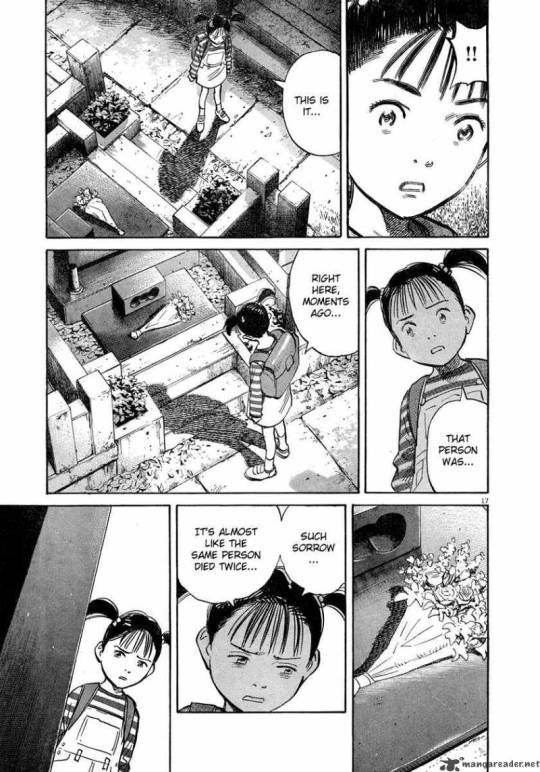
This is made clear by Tenma’s reaction to Atom’s death and to his willingness not to respect any moral or scientific bounds in order to have him back:

Here Tenma is doing something very similar to what he did when Tobio died. He chooses to do what he can to bring his son back even if he knows that he might be giving birth to a demon.
This is important when we consider Gesicht’s story and his role.
Gesicht, like Tenma, is a father who lost a son in a horrible way. His reaction to this loss was pure anger and hate for the child’s killer. The hate was so strong that motivated him to kill a human being despite this going against the robotic laws. It is obvious that if one takes out the fantascientific setting the situation is already one with which we can empathize. Gesicht is portrayed as a very moral person. This is no surprise since he was programmed to be a robot cop. However, when a great injustice hurt him personally he gave in to revenge and broke the law. This is the core of Gesicht’s character and his struggle.
This is important for at least two reasons.
1) The first one is that Gesicht killing the man out of hate is relevant when it comes to his and Mr Haas’s subplot:

Mr Haas’s wife suggests that Gesicht (being him a robot) could not have killed Haas’s brother motivated by such a negative feeling as hate. She argues that what happened must have happened out of necessity while Gesicht was trying to fulfill his duty.
The idea that robots not having emotions can be considered something which makes them better than humans is touched on several times. Here is an example:

A judge whose judgment is not clouded by emotions can be considered better than one who can become irrational due to feelings.
In short, it seems logical to think that Mr Haas’s anger towards Gesicht would be misplaced if the robot killed without hate and justified if the robot killed with hate.
However, this is not how things play out in the end.
As a matter of fact it is specifically the fact that both Haas and Gesicht acted moved by hate that lets them understand each other:

Finally, it is the fact that Gesicht still chose to protect both Mr Haas and his family despite what had occurred between them what finally motivates Mr Haas to change idea about him and hopefully robots in general:

In other words, it is not the fact that Gesicht is unable to feel hate which makes him better than Mr Haas, but the fact that he was able to overcome it. This is what gets through to Mr Haas and inspires him to be better. After all, if Gesicht was simply a person without emotions it would be difficult for Mr Haas to relate to him and it would be easy for him to keep hating the robot as someone inhuman. However, the fact that the two of them are flawed in a very similar way, but that Gesicht still chose to abide to some sort of moral code (like his duty as a policeman) is the proof that Mr Haas has the chance to do the same.
The way things were sorted out between them makes sense also considering Mr Haas’s backstory. As a matter of fact his and his brother’s hate for robots was born by the fact that they were considered better workers than humans and that this led to the brothers’ father being fired. What is more a robot’s too strict application of the law is what led to the man’s death:

The robot was technically right since the brothers’ father had stolen, but at the same time all he stole was a ball to give his children some joy.
In other words, arguments about how robots are better than humans and superior to them are bound not to have the right effect on someone like Mr Haas since his hate is born partially by this exact idea. However, seeing how similar to him Gesicht was managed to obtain some results.
2) The second reason is this:
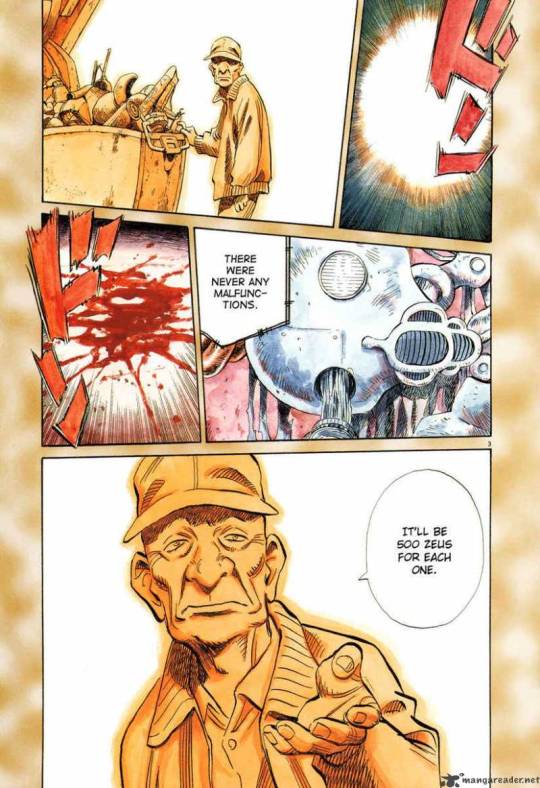
Throughout the story this scene seems to be a part of an extremely dark memory Gesicht is trying to suppress. He is literally haunted by this scene and it keeps coming to his mind when he sees robots’ bodies among other things. In short, everything leads the reader to think that what happened between Gesicht and the man asking money out of him is something negative.
However, when we are finally revealed the context of the scene this is what we discover:

Gesicht’s memory was not an unhappy one, but on the contrary it was him remembering the day he became a father. In other words it is the day Gesicht learnt parental love.
At the same time this scene is at the origin of Gesicht’s hate and violent action. As a matter of fact one can not choose to only have positive emotions. If one feels he is bound to deal with both the good and the bad of it:
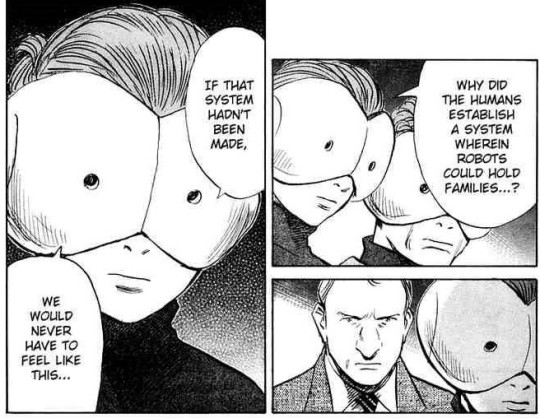
All in all the story if full of love being used to fuel hate and of hate overcome by love.
This becomes apparent in the character of Sahad aka Pluto:
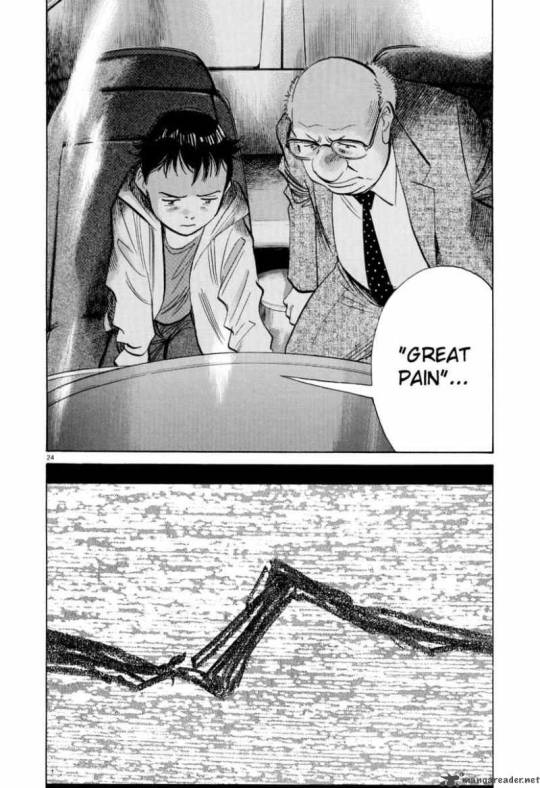
This abstract sign is identified by Atom as a negative feeling and when we meet Pluto for the first time he has been realizing works of abstract art:

This picture might seem chilling at first sight especially if the reader realizes that the robot who has drawn it is Pluto. Uran herself is led to Pluto because she can feel his immense pain and she wants to help him.
However, as Sahad spends more time with Uran in a somehow positive environment he starts to remember what he was originally created for aka his father original wish:

And so what seemed like an abstract mirror of a pained subconscious becomes a wonderful field of flowers able to move Uran to tears.
After all, the whole conflict is born by a huge dream being destroyed by war and by a man losing his children and his wife.
What Abra/Goji wants is revenge and it is meaningful that he tries to obtain it through three cyborgs (counting Goji himself) who were originally created to turn the desert into a field of flowers.
The example of Bora is self-explanatory:
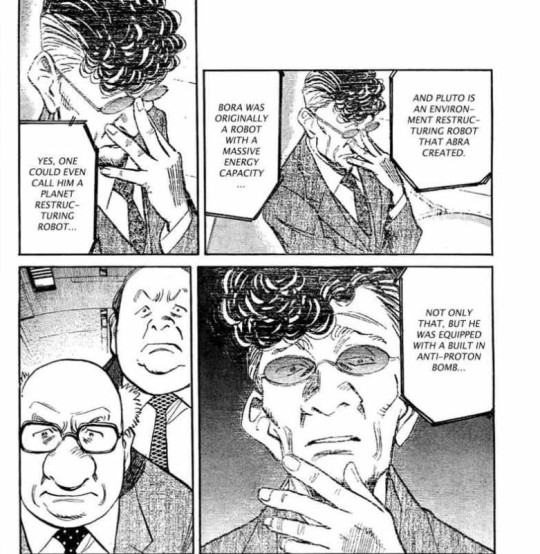
He was supposed to be a robot who could save the planet, but he has been turned into a weapon which could destroy humanity instead.
In short, negative feelings are a part of being humans and they are strongly intertwined with positive ones. These two points come together in Atom’s “resurrection”. This part of the plot is also linked to Gesicht’s arc and his role as a father.
Atom is able to wake up thanks to Gesicht “hate” and Epsilon’s “sadness”:
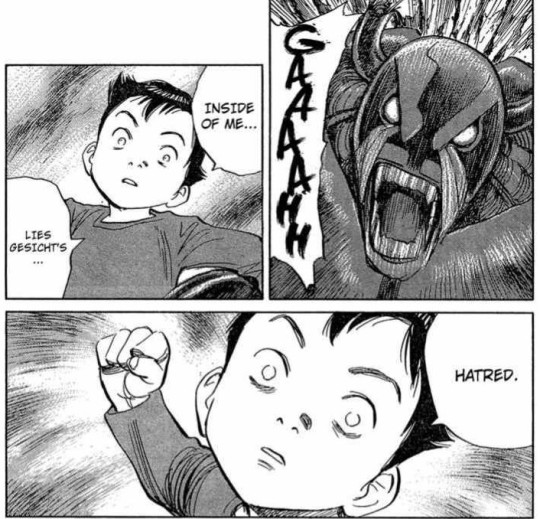

After his awakening he is said to be able to feel hate and this is proven true during his battle against Pluto:
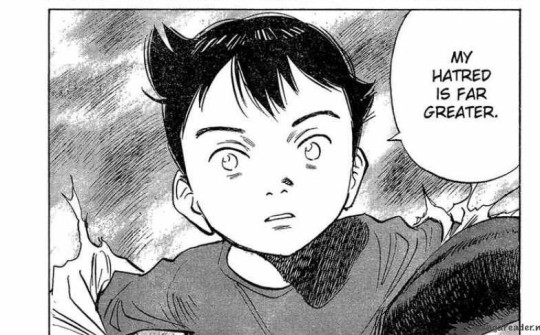
This in itself is important and can be used to make some considerations:

Here Brau claims that Atom has matured to which Atom’s reply is that he can not grow since he is a robot.
This is interesting because the fact that Atom can not grow is one of the reasons why Tenma realized that he was never going to be like Tobio. The other one was Atom’s inability to feel hate. These were the two main reasons why Tenma considered Atom a failure.
However, after his awakening Atom has learnt what hate is and he is said to have matured. What Brau noticed was probably something more similar to a change happened in the inside rather than one happened on the outside.
In other words Atom has grown not because he has matured physically, but because he has now a better understanding of human emotions among which hate.
This is no different than a child growing up and having to learn the complexity of the world and to make sense of their negative feelings.
After all, given Tenma’s description of the perfect AI here:
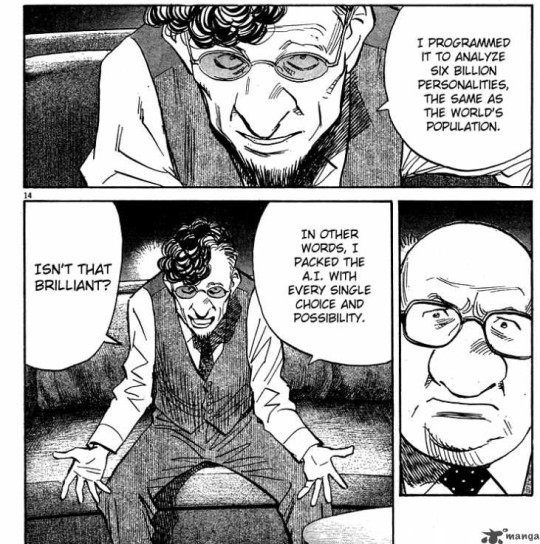
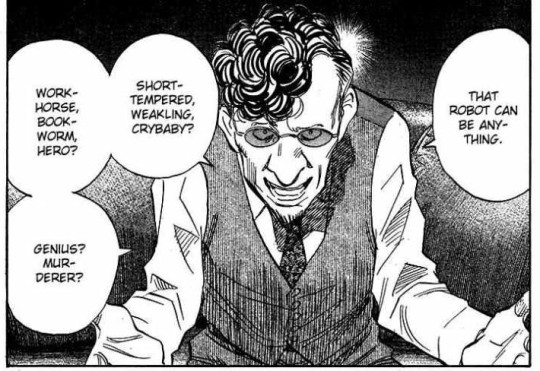
It is difficult not to think of it as a child aka as a being who has in front of themselves all the possibilities and who will grow to become only one of those possibilities.
In a sense this is very similar to what was said in Monster:
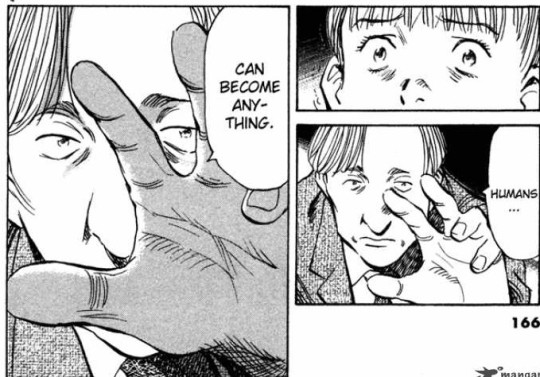
Children can become anything and the parents have a great role in influencing their future developments.
This becomes obvious through Gesicht and Atom’s relationship.
As a matter of fact what Atom learnt from Gesicht is not only what hate is, but also this:

He learnt how to overcome it and that humanity is not just hate, but also hope:
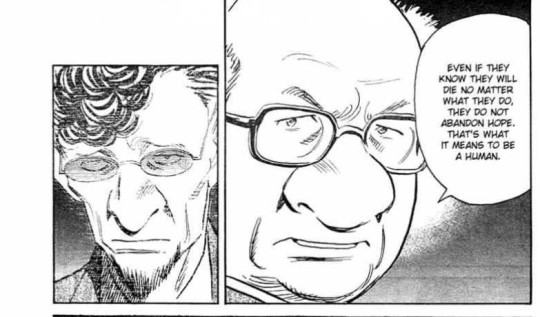
This is why the manga ends with a wish and a prayer which are actions born out of hope:


Let’s also underline how the bomb formula Atom writes down after he wakes up is not just something born out of a new found hatred for the world, but it is probably something he learnt thanks to Epsilon who realized that the Earth was in danger just before dying:

Let us also underline how “sorrow” (aka what Atom learnt from Epsilon) plays a part in the ending just as much as “hate” does. As a matter of fact once Atom overcomes his hatred he starts crying and so does Pluto and the two comment how strange that feeling is. It is also interesting how Epsilon’s death, just like Gesicht’s one is linked to a child. As a matter of fact the two robots both survived a fight against Pluto and gave up the chance to kill him only to then die trying to protect a child.
This is linked to the last point of the analysis i.e. to how Atom surviving is representative of the importance of protecting children and in this way the future itself.
After all, throughout the narrative Atom is paralleled to Gesicht’s child, so it is meaningful that in the end he survives thanks to Gesicht’s sacrifice. At the same time he is the one inheriting Gesicht’s legacy like a child who is taught by a parent. Even if the parent messed up he has still the chance to teach the child to be better. So, Atom is able to put into practice what Gesicht learnt and is able to connect with Pluto.
In conclusion, to answer the question which started this analysis I would say that the Greatest Robot on Earth is not the strongest or the one who exhibits somehow better qualities than humans, but it is a robot who is human and who at the same time is able to learn from humans (like the robots developing emotions by imitating human behaviours), but also to teach humans to be better:
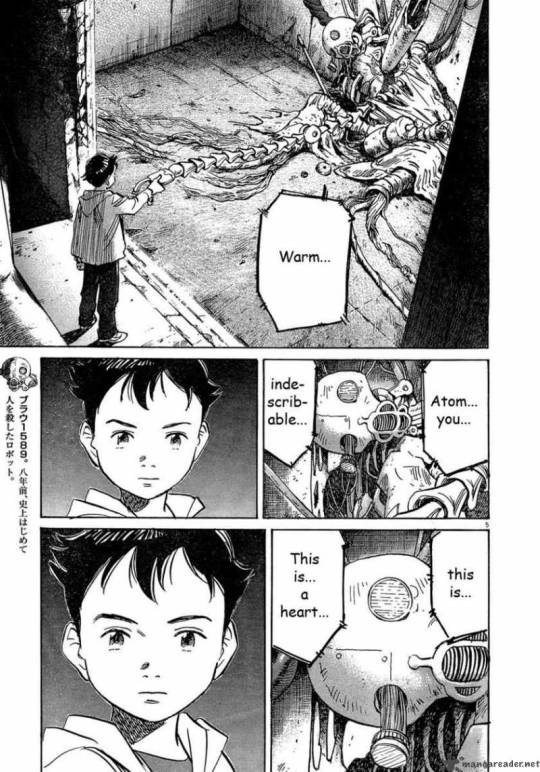
This is evident also in how Brau develops. Brau has always been an AI very similar to humans since he managed to develop hate, but after his meeting with Atom he starts to understand something else. He calls it “a heart” and he is able to feel it both in a person as noble as Atom and in a person as despicable as the President. The fact that in the end he chooses to kill Doctor Roosevelt instead of the President underlines a choice the character makes. Despite how much imperfect humans are Brau still chooses them over an AI who is incredibly advanced and intelligent, but lacks a “heart”.
#naoki urasawa's pluto#naoki urasawa's pluto meta#pluto meta#my meta#gesicht#pluto#tetsuwan atom#uran#professor tenma#umataro tenma#epsilon#naoki urasawa
209 notes
·
View notes
Text
D.Gray-Man Chapter 231 Translation Notes

Hi DGMers! jeidafei from Kougeki Scans here. I’m a total newbie to scanlation and I’ve never made my own note before. However, I’ve read all THREE versions of the DGM translation for reference, (This just goes to show this fandom’s undying love for the subject matter) and noticed some discrepancies between scan groups...
Not to say who is wrong or right, as translators are also humans (unless AI got over its Google Translate phase and take over our jobs someday!) with different experiences and backgrounds, and as such there is no such thing as right or wrong in a translation.
So, in addition to my translation, I would also like to give readers the opportunity to interpret things freely without the language barrier as well, and maybe share some of my knowledge regarding Japan and the Japanese language accumulated from over a decade of learning Japanese (mostly through D.Gray-Man and Ghibli animes XD) and around three years of living, studying and working full-time in Japan.
1. “生々流転” (seiseiruten or shoujouruten)
The cover art is mind-blowingly beautiful this time. So much so that I’ve been secretly wondering whether Hoshino-sensei spent even more time on the cover than the actual content itself and that’s why we have 20 instead of, like, 40 pages.
Anyway, it also gives us this little conundrum...

@panthaleia has already done a marvelous analysis here and you should check it out! so I won’t be going into details much; I would just like to give you a definition and leave it to your imagination. I admit I’m pretty much stumped by this as it isn’t clear what exactly Hoshino-sensei is referring to by this concept.
Japanese culture and language takes heavy influence from Chinese since ancient times, and there are plenty of these four-letter Chinese idioms in daily use, called 四字熟語 (Yojijukugo), some of which can be challenging for non-native learnersーand even the Japanese themselvesーto fully grasp its concept, considering the wealth of yojijukugo-themed dictionaries and games published in Japan.
The Japanese definition of 生々流転 goes as follows:
すべての物は絶えず生まれては変化し、移り変わっていくこと。▽「生生」は物が次々と生まれ育つこと。「流転」は物事が止まることなく移り変わっていく意。「生生」は「しょうじょう」とも読む。 (source)
A compilative translation of the above and other versions in the source would be nothing is unchanging; all existence is born, constantly changes (and dies) in a cycle that repeats itself endlessly. The emphasis seems to be put on the term of “constant change” and the “neverending cycle” of all existence, rather than the birth and death of living beings, however, and thus I believe my own and Mangastream’s translation of it as “Circle of Life” may not be comprehensive of what Hoshino-sensei is trying to convey.
In my opinion, it could either be interpreted literally to mean the cycle and flow of energy and soul-force that Past!Allen had mentioned to Nea all those years ago, or considering the plot of the current chapter it can also refer to the story coming full circle and returning to the point of its birth, by taking Allen back to Eddystone...Edinston...Edinburgh...Edinsーargh dammit I give upーwhere his story began with his meeting with Mana Walker.
Speaking of which...
2. The Town Where Allen Began
Mangastream called it Eddingston. Starbuds called it Edinston. The D.Gray Wikia adopted Edinstown and that’s what I decided to go with for now.
However, the actual Japanese text is エディンストン, phonetically E-din-su-ton. Thus, the most phonetically accurate would probably be Starbuds’ Edinston. Edinstown can be transliterated back into Japanese as エディンスタウン, whereas Eddingston would probably be エッディングストン to the Japanese folk (I’ve highlighted the difference in spelling).
There you go! Now y’all can call it whichever way you want!
3. Why is Allen so alarmed?

Right after Mana said that he draws all those little “I am here”s like a street graffiti punk so God would be able to find him, Allen looked as if he had recalled something significant. Seeing as Allen is about to tell the tale of his beginnings, this would probably be clarified in the next chapter. However, in my opinion, Mana saying “so he would be able to find me” is reminiscent of this sentence back in Reverse: Lost Fragment of Snow:

Back when he still remembers Nea and his purpose of searching for him, Mana was taking every measure to make sure Nea recognizes him, as he now looks different from his 17-year-old self. Sure, Mana might actually be referring to God this time as he said it; we’d never know until the next chapter at the least, but the memory of Mana’s words back at the circus must have been what shook Allen to the core.
4. はじまり
The term はじまり (hajimari) or “the beginning” seems to be the central theme in this chapter; appearing on the cover page, the first page and the last page of last chapter, emphasizing the fact that both Allen and the plot has now come full circle and returned to where “Allen” began.
This cliffhanger freaks me out though, as I couldn’t see how Hoshino-sensei could tell Allen’s story without repeating Reverse: Lost Fragment of Snow, as that is stated to be the story of how Allen came to be:

Anyway, my fear and frustration of waiting-six-months-for-new-developments aside, hajimari is a very popular to the point of cliched concept in Japan, in my opinion. If you go to karaoke in Japan and type in hajimari in the machine, it would come up with a SH*T TON of songs containing hajimari in the song name, with hajimari no uta (The song of beginnings) and hajimari no basho (The place where it all began, which is also mentioned in this chapter) being some of the most repetitive.
As much as the cherry blossoms are a symbol of Japanese culture, the Japanese people themselves regard the month when the cherry blossoms bloom, April, and the season of Spring, as the marker of new beginnings, of significant turning points in life. The start of school term, start of fiscal year, start of working life and end of childhood, Your Lie in April , etc. all happen in April.
This phenomenon is especially remarkable in Japan. Being the country of uniformity, virtually every school and workplace throughout the country would start their activities in April.
In my experience, Japanese aesthetics revolve around the changing seasons and times a lot, and countless pop songs that are released around March-April would sing of the blooming cherry blossoms swaying to the wind and new beginnings for students graduating from high school or university. In the same manner, songs coming out in Winter would feature slower melodies and the distinctive, ringing, Christmas-ey chime from the likes of music boxes, glockenspiels, triangles or celestas, and songs released in Summer would usually be quicker, livelier with lyrics retelling a fun trip to the beach, firework shows and sunshine (-and bikinis, if you’re listening to AKB48!).
To someone who came from a tropical country with three pretty much indistinguishable, unpleasant seasons (Damn-you-Summer, Damn-you-Summer-with-Rain-and-Floods and Damn-you-Summer-with-Three-Days-of-Winter), the beauty of the Japanese seasons and how the Japanese culture and lifestyle intertwine so closely with it has always fascinated and charmed me.
5. The Gratitude Dilemma
In addition to the seiseiruten conundrum, this chapter also throws up some more challenges for translators. One notable example for me being how to accurately capture the essence of this panel:

Both Starbuds and Mangastream worded this bubble very differently, and I won’t say who is the most accurate, but I will explain my choice of wording the best I can (with a few tips to weary Japanese learners along the way, hopefully). The actual Japanese raw is below:

My atrocious highlighting skills aside, we can clearly see the emphasis given to the suffix てあげよう (te-ageyou) here.
Allen didn’t say it straight out that he’s pitying Kanda or the like, but he’s using the te-ageru form, which means “ [doing something] for your sake” .
The concept of gratitude is important in a strict, seniority-based society like Japan, and accordingly there are two verb suffixes just to show gratitude: when someone else does a favor for us: te-kureru, and when we receive a favor from someone else: te-morau.
Yes, there’s a difference. And this is one of the most troublesome head-scratchers and trick-question-subjects for intermediate learners of Japanese taking the JLPT test (and translators of Japanese songs and manga as well), as to make things worse the Japanese usually omits the subject and/or object of the sentence.
My tip for making sense of this is for te-kureru, the other person must be the subject of the sentence, whereas for te-morau, I/me must be the subject.
Starting to see now why so many of my classmates gave up on Japanese and why so many anime subs/manga translations are sometimes inaccurate?
We also get another instance here:
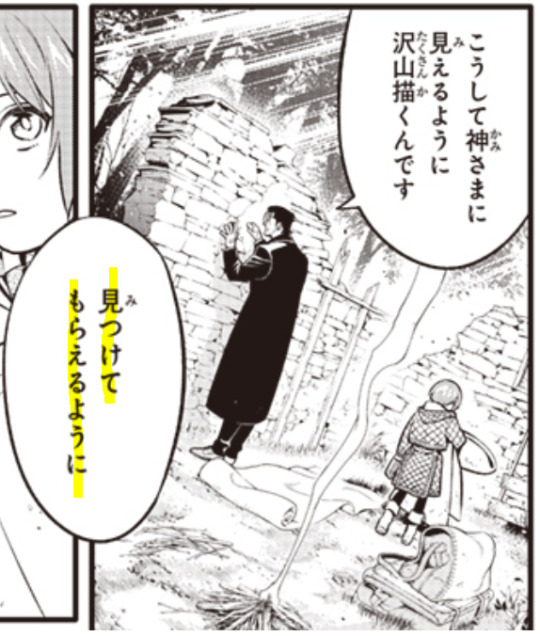
(watashi ha kami ni) mitsukete-moraeru you ni would literally mean something along the lines of so (I) could be found by (God) for my sake. I put parentheses here to show you how both the subject and object of this sentence is omitted, and why we must be extremely careful in cases when it is less clear than this who is doing what for whom. To learners, you MUST pay attention to the conjunctions.
For the sake of convenience and more natural speech I just used so God would be able to find me.
Back to Black Allen, te-ageru or its more casual/demeaning form te-yaru, on the other hand, is used for when we’re doing a favor for someone’s sake and should be used sparingly/carefully to people of the same status or lower, as it could sound patronizing depending on context. So Allen using it to Kanda is meant to be very cheeky and infuriating, as if he’s trying to emphasize that his giving up is more out of pity/sympathy for Kanda’s hapless persistence than his own being tired of or incapable of escaping.
Because in reality it is just as he personally admitted in the earlier page: he’s got no money and cannot elude the Order without Kanda’s help, and decided to just twiddle his thumbs and wait around for now.
But food and a man’s pride are everything to Allen...
That’s all for now. I hope you enjoyed our translations. See you in three months, fellow DGMers!
134 notes
·
View notes